NASA’s Voyager 1 Resumes Sending Engineering Updates to Earth

NASA’s Voyager 1 spacecraft is depicted in this artist’s concept traveling through interstellar space, or the space between stars, which it entered in 2012.
After some inventive sleuthing, the mission team can — for the first time in five months — check the health and status of the most distant human-made object in existence.
For the first time since November , NASA’s Voyager 1 spacecraft is returning usable data about the health and status of its onboard engineering systems. The next step is to enable the spacecraft to begin returning science data again. The probe and its twin, Voyager 2, are the only spacecraft to ever fly in interstellar space (the space between stars).
Voyager 1 stopped sending readable science and engineering data back to Earth on Nov. 14, 2023, even though mission controllers could tell the spacecraft was still receiving their commands and otherwise operating normally. In March, the Voyager engineering team at NASA’s Jet Propulsion Laboratory in Southern California confirmed that the issue was tied to one of the spacecraft’s three onboard computers, called the flight data subsystem (FDS). The FDS is responsible for packaging the science and engineering data before it’s sent to Earth.

After receiving data about the health and status of Voyager 1 for the first time in five months, members of the Voyager flight team celebrate in a conference room at NASA’s Jet Propulsion Laboratory on April 20.
The team discovered that a single chip responsible for storing a portion of the FDS memory — including some of the FDS computer’s software code — isn’t working. The loss of that code rendered the science and engineering data unusable. Unable to repair the chip, the team decided to place the affected code elsewhere in the FDS memory. But no single location is large enough to hold the section of code in its entirety.
So they devised a plan to divide the affected code into sections and store those sections in different places in the FDS. To make this plan work, they also needed to adjust those code sections to ensure, for example, that they all still function as a whole. Any references to the location of that code in other parts of the FDS memory needed to be updated as well.
The team started by singling out the code responsible for packaging the spacecraft’s engineering data. They sent it to its new location in the FDS memory on April 18. A radio signal takes about 22 ½ hours to reach Voyager 1, which is over 15 billion miles (24 billion kilometers) from Earth, and another 22 ½ hours for a signal to come back to Earth. When the mission flight team heard back from the spacecraft on April 20, they saw that the modification worked: For the first time in five months, they have been able to check the health and status of the spacecraft.
Get the Latest News from the Final Frontier
During the coming weeks, the team will relocate and adjust the other affected portions of the FDS software. These include the portions that will start returning science data.
Voyager 2 continues to operate normally. Launched over 46 years ago , the twin Voyager spacecraft are the longest-running and most distant spacecraft in history. Before the start of their interstellar exploration, both probes flew by Saturn and Jupiter, and Voyager 2 flew by Uranus and Neptune.
Caltech in Pasadena, California, manages JPL for NASA.

News Media Contact
Calla Cofield
Jet Propulsion Laboratory, Pasadena, Calif.
626-808-2469
- International edition
- Australia edition
- Europe edition

Voyager 1 transmitting data again after Nasa remotely fixes 46-year-old probe
Engineers spent months working to repair link with Earth’s most distant spacecraft, says space agency
Earth’s most distant spacecraft, Voyager 1, has started communicating properly again with Nasa after engineers worked for months to remotely fix the 46-year-old probe.
Nasa’s Jet Propulsion Laboratory (JPL), which makes and operates the agency’s robotic spacecraft, said in December that the probe – more than 15bn miles (24bn kilometres) away – was sending gibberish code back to Earth.
In an update released on Monday , JPL announced the mission team had managed “after some inventive sleuthing” to receive usable data about the health and status of Voyager 1’s engineering systems. “The next step is to enable the spacecraft to begin returning science data again,” JPL said. Despite the fault, Voyager 1 had operated normally throughout, it added.
Launched in 1977, Voyager 1 was designed with the primary goal of conducting close-up studies of Jupiter and Saturn in a five-year mission. However, its journey continued and the spacecraft is now approaching a half-century in operation.
Voyager 1 crossed into interstellar space in August 2012, making it the first human-made object to venture out of the solar system. It is currently travelling at 37,800mph (60,821km/h).
Hi, it's me. - V1 https://t.co/jgGFBfxIOe — NASA Voyager (@NASAVoyager) April 22, 2024
The recent problem was related to one of the spacecraft’s three onboard computers, which are responsible for packaging the science and engineering data before it is sent to Earth. Unable to repair a broken chip, the JPL team decided to move the corrupted code elsewhere, a tricky job considering the old technology.
The computers on Voyager 1 and its sister probe, Voyager 2, have less than 70 kilobytes of memory in total – the equivalent of a low-resolution computer image. They use old-fashioned digital tape to record data.
The fix was transmitted from Earth on 18 April but it took two days to assess if it had been successful as a radio signal takes about 22 and a half hours to reach Voyager 1 and another 22 and a half hours for a response to come back to Earth. “When the mission flight team heard back from the spacecraft on 20 April, they saw that the modification worked,” JPL said.
Alongside its announcement, JPL posted a photo of members of the Voyager flight team cheering and clapping in a conference room after receiving usable data again, with laptops, notebooks and doughnuts on the table in front of them.
The Retired Canadian astronaut Chris Hadfield, who flew two space shuttle missions and acted as commander of the International Space Station, compared the JPL mission to long-distance maintenance on a vintage car.
“Imagine a computer chip fails in your 1977 vehicle. Now imagine it’s in interstellar space, 15bn miles away,” Hadfield wrote on X . “Nasa’s Voyager probe just got fixed by this team of brilliant software mechanics.
Voyager 1 and 2 have made numerous scientific discoveries , including taking detailed recordings of Saturn and revealing that Jupiter also has rings, as well as active volcanism on one of its moons, Io. The probes later discovered 23 new moons around the outer planets.
As their trajectory takes them so far from the sun, the Voyager probes are unable to use solar panels, instead converting the heat produced from the natural radioactive decay of plutonium into electricity to power the spacecraft’s systems.
Nasa hopes to continue to collect data from the two Voyager spacecraft for several more years but engineers expect the probes will be too far out of range to communicate in about a decade, depending on how much power they can generate. Voyager 2 is slightly behind its twin and is moving slightly slower.
In roughly 40,000 years, the probes will pass relatively close, in astronomical terms, to two stars. Voyager 1 will come within 1.7 light years of a star in the constellation Ursa Minor, while Voyager 2 will come within a similar distance of a star called Ross 248 in the constellation of Andromeda.

Cosmic cleaners: the scientists scouring English cathedral roofs for space dust

Russia acknowledges continuing air leak from its segment of space station

Uncontrolled European satellite falls to Earth after 30 years in orbit

Cosmonaut Oleg Kononenko sets world record for most time spent in space

‘Old smokers’: astronomers discover giant ancient stars in Milky Way

Nasa postpones plans to send humans to moon

What happened to the Peregrine lander and what does it mean for moon missions?

Peregrine 1 has ‘no chance’ of landing on moon due to fuel leak
Most viewed.
Inside NASA's 5-month fight to save the Voyager 1 mission in interstellar space

After working for five months to re-establish communication with the farthest-flung human-made object in existence, NASA announced this week that the Voyager 1 probe had finally phoned home.
For the engineers and scientists who work on NASA’s longest-operating mission in space, it was a moment of joy and intense relief.
“That Saturday morning, we all came in, we’re sitting around boxes of doughnuts and waiting for the data to come back from Voyager,” said Linda Spilker, the project scientist for the Voyager 1 mission at NASA’s Jet Propulsion Laboratory in Pasadena, California. “We knew exactly what time it was going to happen, and it got really quiet and everybody just sat there and they’re looking at the screen.”
When at long last the spacecraft returned the agency’s call, Spilker said the room erupted in celebration.
“There were cheers, people raising their hands,” she said. “And a sense of relief, too — that OK, after all this hard work and going from barely being able to have a signal coming from Voyager to being in communication again, that was a tremendous relief and a great feeling.”

The problem with Voyager 1 was first detected in November . At the time, NASA said it was still in contact with the spacecraft and could see that it was receiving signals from Earth. But what was being relayed back to mission controllers — including science data and information about the health of the probe and its various systems — was garbled and unreadable.
That kicked off a monthslong push to identify what had gone wrong and try to save the Voyager 1 mission.
Spilker said she and her colleagues stayed hopeful and optimistic, but the team faced enormous challenges. For one, engineers were trying to troubleshoot a spacecraft traveling in interstellar space , more than 15 billion miles away — the ultimate long-distance call.
“With Voyager 1, it takes 22 1/2 hours to get the signal up and 22 1/2 hours to get the signal back, so we’d get the commands ready, send them up, and then like two days later, you’d get the answer if it had worked or not,” Spilker said.

The team eventually determined that the issue stemmed from one of the spacecraft’s three onboard computers. Spilker said a hardware failure, perhaps as a result of age or because it was hit by radiation, likely messed up a small section of code in the memory of the computer. The glitch meant Voyager 1 was unable to send coherent updates about its health and science observations.
NASA engineers determined that they would not be able to repair the chip where the mangled software is stored. And the bad code was also too large for Voyager 1's computer to store both it and any newly uploaded instructions. Because the technology aboard Voyager 1 dates back to the 1960s and 1970s, the computer’s memory pales in comparison to any modern smartphone. Spilker said it’s roughly equivalent to the amount of memory in an electronic car key.
The team found a workaround, however: They could divide up the code into smaller parts and store them in different areas of the computer’s memory. Then, they could reprogram the section that needed fixing while ensuring that the entire system still worked cohesively.
That was a feat, because the longevity of the Voyager mission means there are no working test beds or simulators here on Earth to test the new bits of code before they are sent to the spacecraft.
“There were three different people looking through line by line of the patch of the code we were going to send up, looking for anything that they had missed,” Spilker said. “And so it was sort of an eyes-only check of the software that we sent up.”
The hard work paid off.
NASA reported the happy development Monday, writing in a post on X : “Sounding a little more like yourself, #Voyager1.” The spacecraft’s own social media account responded , saying, “Hi, it’s me.”
So far, the team has determined that Voyager 1 is healthy and operating normally. Spilker said the probe’s scientific instruments are on and appear to be working, but it will take some time for Voyager 1 to resume sending back science data.
Voyager 1 and its twin, the Voyager 2 probe, each launched in 1977 on missions to study the outer solar system. As it sped through the cosmos, Voyager 1 flew by Jupiter and Saturn, studying the planets’ moons up close and snapping images along the way.
Voyager 2, which is 12.6 billion miles away, had close encounters with Jupiter, Saturn, Uranus and Neptune and continues to operate as normal.
In 2012, Voyager 1 ventured beyond the solar system , becoming the first human-made object to enter interstellar space, or the space between stars. Voyager 2 followed suit in 2018.
Spilker, who first began working on the Voyager missions when she graduated college in 1977, said the missions could last into the 2030s. Eventually, though, the probes will run out of power or their components will simply be too old to continue operating.
Spilker said it will be tough to finally close out the missions someday, but Voyager 1 and 2 will live on as “our silent ambassadors.”
Both probes carry time capsules with them — messages on gold-plated copper disks that are collectively known as The Golden Record . The disks contain images and sounds that represent life on Earth and humanity’s culture, including snippets of music, animal sounds, laughter and recorded greetings in different languages. The idea is for the probes to carry the messages until they are possibly found by spacefarers in the distant future.
“Maybe in 40,000 years or so, they will be getting relatively close to another star,” Spilker said, “and they could be found at that point.”
Denise Chow is a reporter for NBC News Science focused on general science and climate change.
Voyager 1 Sends Clear Data to NASA for the First Time in Five Months
The farthest spacecraft from Earth had been transmitting nonsense since November, but after an engineering tweak, it finally beamed back a report on its health and status
/https://tf-cmsv2-smithsonianmag-media.s3.amazonaws.com/accounts/headshot/Will-Sullivan-photo.png)
Will Sullivan
Daily Correspondent
:focal(2016x1133:2017x1134)/https://tf-cmsv2-smithsonianmag-media.s3.amazonaws.com/filer_public/32/30/3230d19e-cc50-4905-840c-7f3afeb2a0c3/e1-pia26275-voyager-copy-16.jpg)
For the first time in five months, NASA has received usable data from Voyager 1, the farthest spacecraft from Earth.
The aging probe, which has traveled more than 15 billion miles into space, stopped transmitting science and engineering data on November 14. Instead, it sent NASA a nonsensical stream of repetitive binary code . For months, the agency’s engineers undertook a slow process of trial and error, giving the spacecraft various commands and waiting to see how it responded. Thanks to some creative thinking, the team identified a broken chip on the spacecraft and relocated some of the code that was stored there, according to the agency .
NASA is now receiving data about the health and status of Voyager 1’s engineering systems. The next step is to get the spacecraft to start sending science data again.
“Today was a great day for Voyager 1,” Linda Spilker , a Voyager project scientist at NASA’s Jet Propulsion Laboratory (JPL), said in a statement over the weekend, per CNN ’s Ashley Strickland. “We’re back in communication with the spacecraft. And we look forward to getting science data back.”
Hi, it's me. - V1 https://t.co/jgGFBfxIOe — NASA Voyager (@NASAVoyager) April 22, 2024
Voyager 1 and its companion, Voyager 2, separately launched from Earth in 1977. Between the two of them, the probes have studied all four giant planets in the outer solar system—Jupiter, Saturn, Uranus and Neptune—along with 48 of their moons and the planets’ magnetic fields. The spacecraft observed Saturn’s rings in detail and discovered active volcanoes on Jupiter’s moon Io .
Originally designed for a five-year mission within our solar system, both probes are still operational and chugging along through space, far beyond Pluto’s orbit. In 2012, Voyager 1 became the first human-made object to reach interstellar space, the area between stars. The probe is now about eight times farther from the sun than Uranus is on average.
Over the decades, the Voyager spacecraft have transmitted data collected on their travels back to NASA scientists. But in November, Voyager 1 started sending gibberish .
Engineers determined Voyager 1’s issue was with one of three onboard computers, called the flight data system (FDS), NASA said in a December blog post . While the spacecraft was still receiving and executing commands from Earth, the FDS was not communicating properly with a subsystem called the telemetry modulation unit (TMU). The FDS collects science and engineering data and combines it into a package that the TMU transmits back to Earth.
Since Voyager 1 is so far away, testing solutions to its technical issues requires time—it takes 22.5 hours for commands to reach the probe and another 22.5 hours for Voyager 1’s response to come back.
On March 1, engineers sent a command that coaxed Voyager 1 into sending a readout of the FDS memory, NASA said in a March 13 blog post . From that readout, the team confirmed a small part—about 3 percent—of the system’s memory had been corrupted, NASA said in an April 4 update .
The core of the problem turned out to be a faulty chip hosting some software code and part of the FDS memory. NASA doesn’t know what caused the chip to stop working—it could be that a high-energy particle from space collided with it, or the chip might have just run out of steam after almost 50 years spent hurtling through the cosmos.
“It’s the most serious issue we’ve had since I’ve been the project manager, and it’s scary because you lose communication with the spacecraft,” Suzanne Dodd , Voyager project manager at JPL, told Scientific American ’s Nadia Drake in March.
To receive usable data again, the engineers needed to move the affected code somewhere else that wasn’t broken. But no single location in the FDS memory was large enough to hold all of the code, so the engineers divided it into chunks and stored it in multiple places, per NASA .
The team started with moving the code responsible for sending Voyager’s status reports, sending it to its new location in the FDS memory on April 18. They received confirmation that the strategy worked on April 20, when the first data on the spacecraft’s health since November arrived on Earth.
In the next several weeks, the team will relocate the parts of the FDS software that can start returning science data.
Get the latest stories in your inbox every weekday.
/https://tf-cmsv2-smithsonianmag-media.s3.amazonaws.com/accounts/headshot/Will-Sullivan-photo.png)
Will Sullivan | | READ MORE
Will Sullivan is a science writer based in Washington, D.C. His work has appeared in Inside Science and NOVA Next .
April 22, 2024
After Months of Gibberish, Voyager 1 Is Communicating Well Again
NASA scientists spent months coaxing the 46-year-old Voyager 1 spacecraft back into healthy communication
By Meghan Bartels
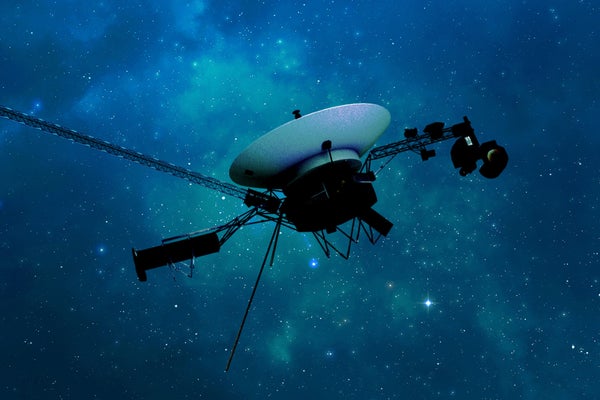
NASA’s Voyager 1 spacecraft is depicted in this artist’s concept traveling through interstellar space, or the space between stars, which it entered in 2012.
NASA/JPL-Caltech
After months of nonsensical transmissions from humanity’s most distant emissary, NASA’s iconic Voyager 1 spacecraft is finally communicating intelligibly with Earth again.
Voyager 1 launched in 1977 , zipped past Jupiter and Saturn within just a few years and has been trekking farther from our sun ever since; the craft crossed into interstellar space in 2012. But in mid-November 2023 Voyager 1’s data transmissions became garbled , sending NASA engineers on a slow quest to troubleshoot the distant spacecraft. Finally, that work has paid off, and NASA has clear information on the probe’s health and status, the agency announced on April 22.
“It’s the most serious issue we’ve had since I’ve been the project manager, and it’s scary because you lose communication with the spacecraft,” said Suzanne Dodd, Voyager project manager at NASA’s Jet Propulsion Laboratory in an interview with Scientific American when the team was still tracking down the issue.
On supporting science journalism
If you're enjoying this article, consider supporting our award-winning journalism by subscribing . By purchasing a subscription you are helping to ensure the future of impactful stories about the discoveries and ideas shaping our world today.
The Voyager 1 spacecraft is a scientific legend : It discovered that Jupiter’s moon Io, far from being a dead world like our own companion, is instead a supervolcanic world . The craft’s data suggested that Saturn’s moon Titan might have liquid on its surface. And for more than a decade, Voyager 1 has given scientists a glimpse at what space looks like beyond the influence of our sun.
Yet its long years in the harsh environment of space have done a number on the probe, which was designed to last just four years. In particular, degraded performance and low power supplies have forced NASA to turn off six of its 10 instruments, and its communication has gotten even spottier than can be explained by the fact that cosmic mechanics mean a signal takes nearly one Earth day to travel between humans and the probe.
When the latest communications glitch occurred last fall, scientists could still send signals to the distant probe, and they could tell that the spacecraft was operating. But all they got from Voyager 1 was gibberish—what NASA described in December 2023 as “a repeating pattern of ones and zeros.” The team was able to trace the issue back to a part of the spacecraft’s computer system called the flight data subsystem, or FDS, and identified that a particular chip within that system had failed.
Mission personnel couldn’t repair the chip. They were, however, able to break the code held on the failed chip into pieces they could tuck into spare corners of the FDS’s memory, according to NASA. The first such fix was transmitted to Voyager 1 on April 18. With a total distance of 30 billion miles to cross from Earth to the spacecraft and back, the team had to wait nearly two full days for a response from the probe. But on April 20 NASA got confirmation that the initial fix worked. Additional commands to rewrite the rest of the FDS system’s lost code are scheduled for the coming weeks, according to the space agency, including commands that will restore the spacecraft’s ability to send home science data.
Although, for now, Voyager 1 appears to be on the mend, NASA scientists know it won’t last forever. Sooner or later, a glitch they can’t fix will occur, or the spacecraft’s ever dwindling fuel supply will run out for good. Until then NASA is determined to get as much data as possible out of the venerable spacecraft—and its twin, Voyager 2, which experienced its own communications glitch earlier in 2023 .

Suggested Searches
- Climate Change
- Expedition 64
- Mars perseverance
- SpaceX Crew-2
- International Space Station
- View All Topics A-Z
Humans in Space
Earth & climate, the solar system, the universe, aeronautics, learning resources, news & events.

NASA-Led Study Provides New Global Accounting of Earth’s Rivers

NASA’s Hubble Pauses Science Due to Gyro Issue

NASA’s Optical Comms Demo Transmits Data Over 140 Million Miles
- Search All NASA Missions
- A to Z List of Missions
- Upcoming Launches and Landings
- Spaceships and Rockets
- Communicating with Missions
- James Webb Space Telescope
- Hubble Space Telescope
- Why Go to Space
- Astronauts Home
- Commercial Space
- Destinations
- Living in Space
- Explore Earth Science
- Earth, Our Planet
- Earth Science in Action
- Earth Multimedia
- Earth Science Researchers
- Pluto & Dwarf Planets
- Asteroids, Comets & Meteors
- The Kuiper Belt
- The Oort Cloud
- Skywatching
- The Search for Life in the Universe
- Black Holes
- The Big Bang
- Dark Energy & Dark Matter
- Earth Science
- Planetary Science
- Astrophysics & Space Science
- The Sun & Heliophysics
- Biological & Physical Sciences
- Lunar Science
- Citizen Science
- Astromaterials
- Aeronautics Research
- Human Space Travel Research
- Science in the Air
- NASA Aircraft
- Flight Innovation
- Supersonic Flight
- Air Traffic Solutions
- Green Aviation Tech
- Drones & You
- Technology Transfer & Spinoffs
- Space Travel Technology
- Technology Living in Space
- Manufacturing and Materials
- Science Instruments
- For Kids and Students
- For Educators
- For Colleges and Universities
- For Professionals
- Science for Everyone
- Requests for Exhibits, Artifacts, or Speakers
- STEM Engagement at NASA
- NASA's Impacts
- Centers and Facilities
- Directorates
- Organizations
- People of NASA
- Internships
- Our History
- Doing Business with NASA
- Get Involved
- Aeronáutica
- Ciencias Terrestres
- Sistema Solar
- All NASA News
- Video Series on NASA+
- Newsletters
- Social Media
- Media Resources
- Upcoming Launches & Landings
- Virtual Events
- Sounds and Ringtones
- Interactives
- STEM Multimedia

Correction and Clarification of C.26 Rapid Mission Design Studies for Mars Sample Return

NASA’s Commercial Partners Deliver Cargo, Crew for Station Science

NASA Shares Lessons of Human Systems Integration with Industry

Work Underway on Large Cargo Landers for NASA’s Artemis Moon Missions

NASA’s ORCA, AirHARP Projects Paved Way for PACE to Reach Space

Amendment 11: Physical Oceanography not solicited in ROSES-2024

Why is Methane Seeping on Mars? NASA Scientists Have New Ideas

Mars Science Laboratory: Curiosity Rover

Hubble Spots a Magnificent Barred Galaxy

NASA’s Chandra Releases Doubleheader of Blockbuster Hits

Explore the Universe with the First E-Book from NASA’s Fermi

NASA Grant Brings Students at Underserved Institutions to the Stars

NASA Photographer Honored for Thrilling Inverted In-Flight Image

NASA’s Ingenuity Mars Helicopter Team Says Goodbye … for Now

NASA Langley Team to Study Weather During Eclipse Using Uncrewed Vehicles

NASA Data Helps Beavers Build Back Streams

NASA’s Near Space Network Enables PACE Climate Mission to ‘Phone Home’

Washington State High Schooler Wins 2024 NASA Student Art Contest

NASA STEM Artemis Moon Trees


Kiyun Kim: From Intern to Accessibility Advocate

Diez maneras en que los estudiantes pueden prepararse para ser astronautas

Astronauta de la NASA Marcos Berríos

Resultados científicos revolucionarios en la estación espacial de 2023
45 years ago: voyager 1 begins its epic journey to the outer planets and beyond, johnson space center.
Forty-five years ago, the Voyager 1 spacecraft began an epic journey that continues to this day. The second of a pair of spacecraft, Voyager 1 lifted off on Sept. 5, 1977, 16 days after its twin left on a similar voyage. NASA’s Jet Propulsion Laboratory (JPL) in Pasadena, California, managed the two spacecraft on their missions to explore the outer planets. Taking advantage of a rare planetary alignment to use the gravity of one planet to redirect the spacecraft to the next, the Voyagers planned to use Jupiter’s gravity to send them on to explore Saturn and its large moon Titan. They carried sophisticated instruments to conduct their in-depth explorations of the giant planets. Both spacecraft continue to return data as they make their way out of our solar system and enter interstellar space.
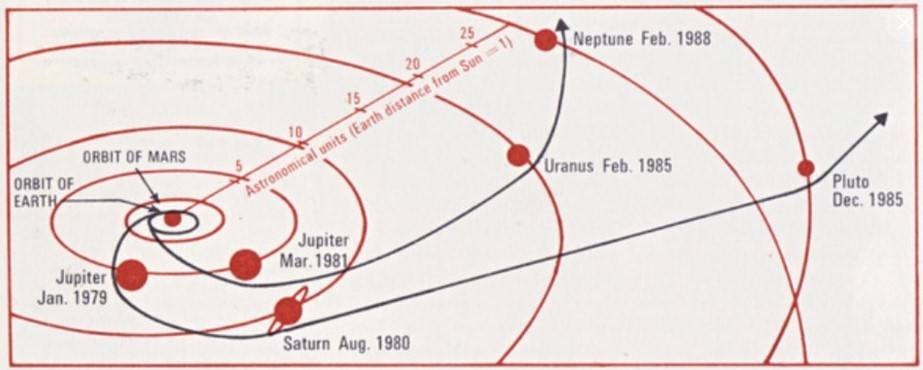
In the 1960s, mission designers at JPL noted that the next occurrence of a once-every-175-year alignment of the outer planets would happen in the late 1970s. A spacecraft could take advantage of this opportunity to fly by Jupiter and use its gravity to bend its trajectory to visit Saturn, and repeat the process to also visit Uranus, Neptune, and Pluto. Launching several missions to visit each planet individually would take much longer and cost much more. The original plan to send two pairs of Thermoelectric Outer Planet Spacecraft on these Grand Tours proved too costly leading to its cancellation in 1971. The next year, NASA approved a scaled-down version of the project to send a pair of Mariner-class spacecraft in 1977 to explore just Jupiter and Saturn, with an expected five-year operational life. On March 7, 1977, NASA Administrator James C. Fletcher announced the renaming of these Mariner Jupiter/Saturn 1977 spacecraft as Voyager 1 and 2. Scientists held out hope that one of them could ultimately visit Uranus and Neptune, thereby fulfilling most of the original Grand Tour’s objectives – Pluto would have to wait several decades for its first visit.
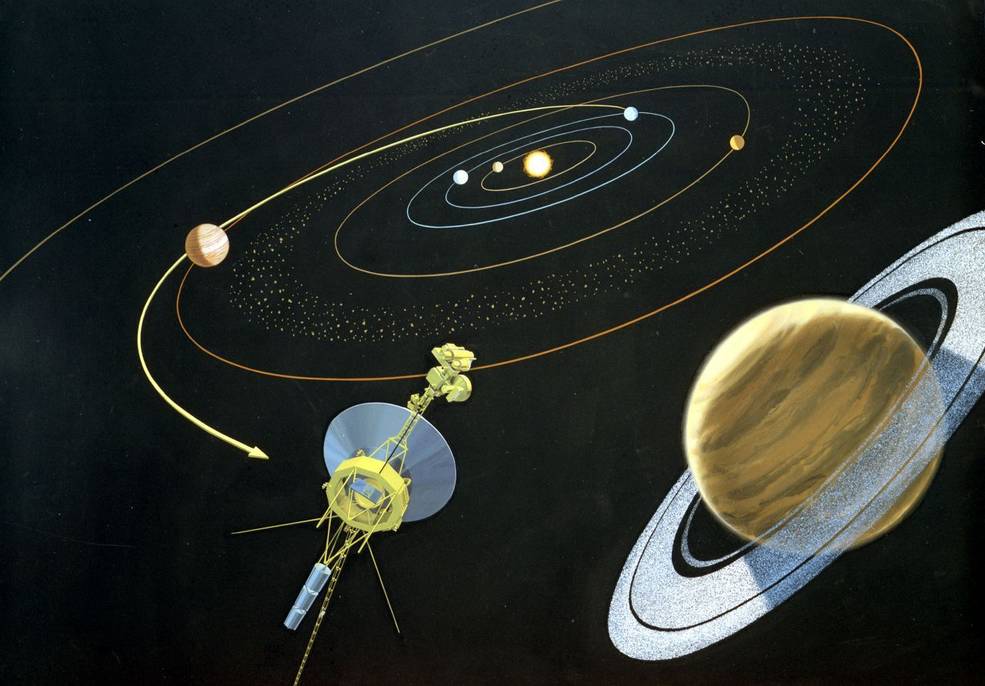
Each Voyager carried a suite of 11 instruments to study the planets during each encounter and to learn more about interplanetary space in the outer reaches of the solar system, including:
- An imaging science system consisting of narrow-angle and wide-angle cameras to photograph the planet and its satellites.
- A radio science system to determine the planet’s physical properties.
- An infrared interferometer spectrometer to investigate local and global energy balance and atmospheric composition.
- An ultraviolet spectrometer to measure atmospheric properties.
- A magnetometer to analyze the planet’s magnetic field and interaction with the solar wind.
- A plasma spectrometer to investigate microscopic properties of plasma ions.
- A low-energy charged particle device to measure fluxes and distributions of ions.
- A cosmic ray detection system to determine the origin and behavior of cosmic radiation.
- A planetary radio astronomy investigation to study radio emissions from Jupiter.
- A photopolarimeter to measure the planet’s surface composition.
- A plasma wave system to study the planet’s magnetosphere.
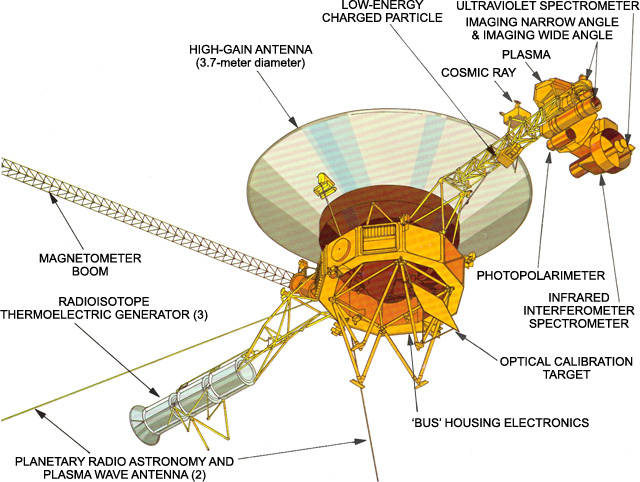
Voyager 1 lifted off on Sept. 5, 1977, atop a Titan IIIE-Centaur rocket from Launch Complex 41 at Cape Canaveral Air Force Station, now Cape Canaveral Space Force Station, in Florida. Two weeks after its launch, from a distance of 7.25 million miles, Voyager 1 turned its camera back toward its home planet and took the first single-frame image of the Earth-Moon system. The spacecraft successfully crossed the asteroid belt between Dec. 10, 1977, and Sept. 8, 1978.
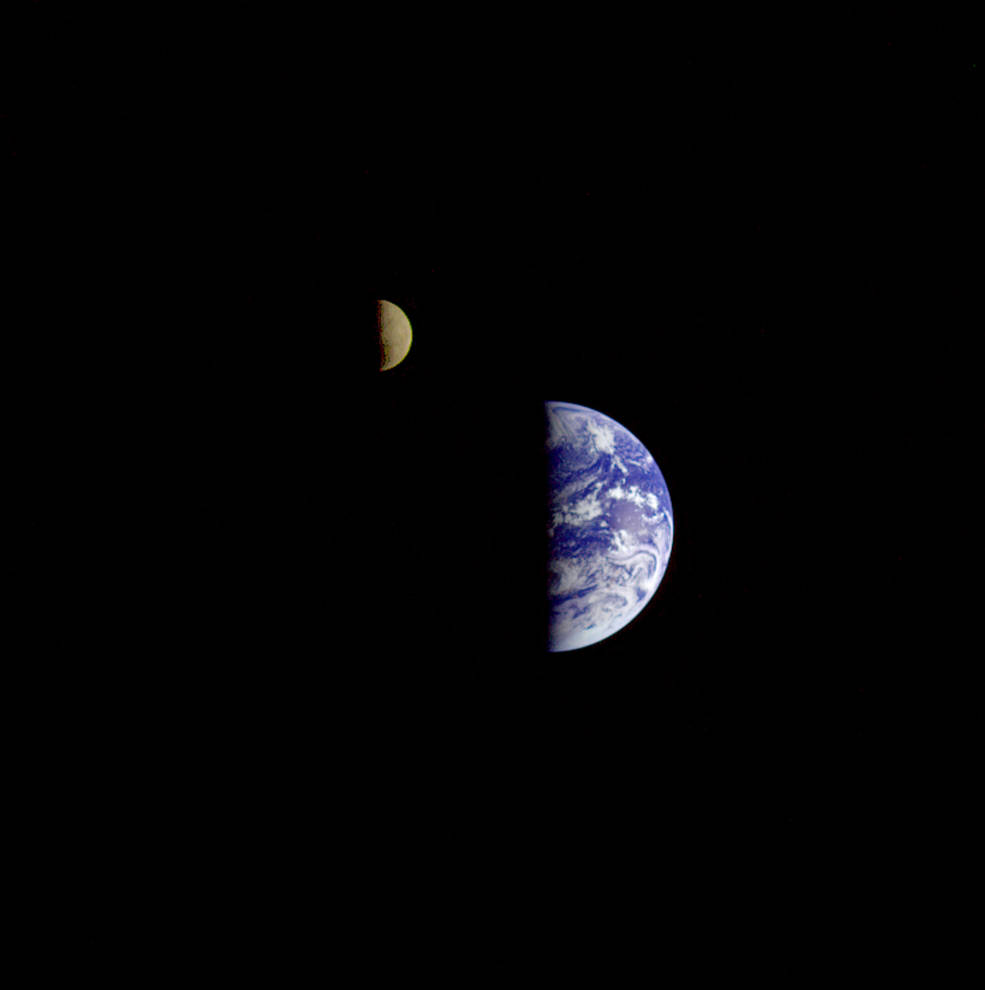
Although Voyager 1 launched two weeks after its twin, it traveled on a faster trajectory and arrived at Jupiter four months earlier. Voyager 1 conducted its observations of Jupiter between Jan. 6 and April 13, 1979, making its closest approach of 216,837 miles from the planet’s center on March 5. The spacecraft returned 19,000 images of the giant planet, many of Jupiter’s satellites, and confirmed the presence of a thin ring encircling it. Its other instruments returned information about Jupiter’s atmosphere and magnetic field. Jupiter’s massive gravity field bent the spacecraft’s trajectory and accelerated it toward Saturn.
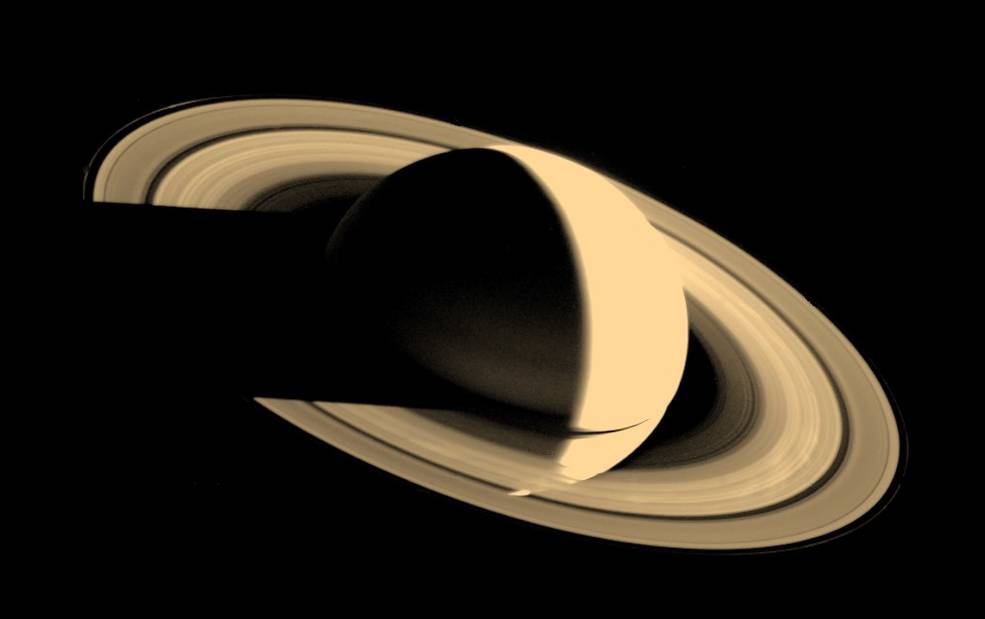
Voyager 1 began its long-range observations of Saturn on Aug. 22, 1980, passed within 114,500 miles of the planet’s center on Nov. 12, and concluded its studies on Dec. 14. Because of its interest to scientists, mission planners chose the spacecraft’s trajectory to make a close flyby of Saturn’s largest moon Titan – the only planetary satellite with a dense atmosphere – just before the closest approach to the planet itself. This trajectory, passing over Saturn’s south pole and bending north over the plane of the ecliptic, precluded Voyager 1 from making any additional planetary encounters. The spacecraft flew 4,033 miles from Titan’s center, returning images of its unbroken orange atmosphere and high-altitude blue haze layer. During the encounter, Voyager 1 returned 16,000 photographs, imaging Saturn, its rings, many of its known satellites and discovering several new ones, while its instruments returned data about Saturn’s atmosphere and magnetic field.

On Feb. 14, 1990, more than 12 years after it began its journey from Earth and shortly before controllers permanently turned off its cameras to conserve power, Voyager 1 spun around and pointed them back into the solar system. In a mosaic of 60 images, it captured a “family portrait” of six of the solar system’s planets, including a pale blue dot called Earth more than 3.7 billion miles away. Fittingly, these were the last pictures returned from either Voyager spacecraft. On Feb. 17, 1998, Voyager 1 became the most distant human-made object, overtaking the Pioneer 10 spacecraft on their way out of the solar system. In February 2020, to commemorate the photograph’s 30th anniversary, NASA released a remastered version of the image of Earth as Pale Blue Dot Revisited .
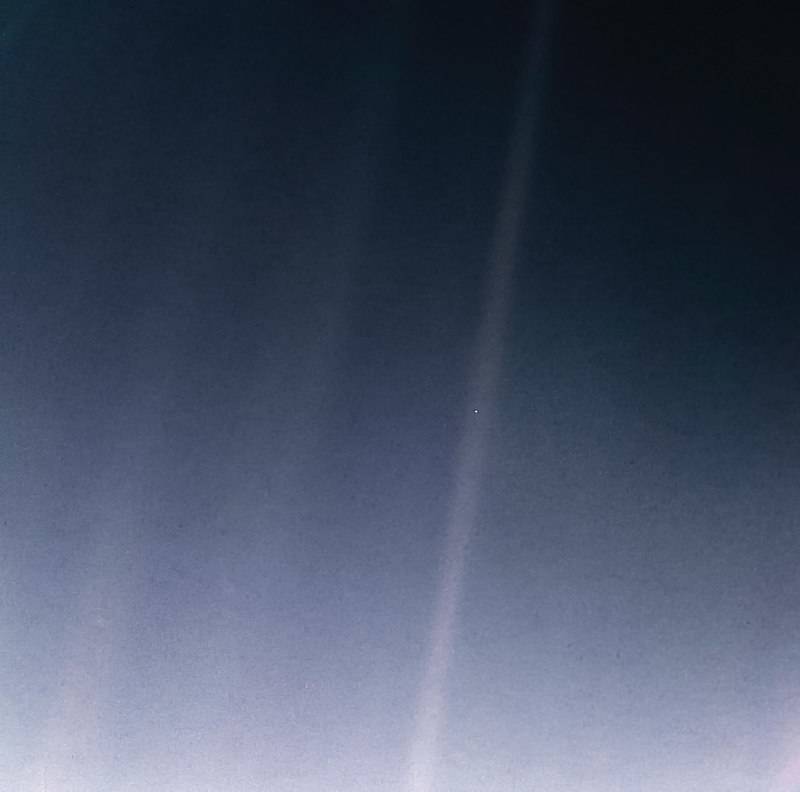
On New Year’s Day 1990, both spacecraft officially began the Voyager Interstellar Mission as they inexorably made their escape from our solar system. On Aug. 25, 2012, Voyager 1 passed beyond the heliopause, the boundary between the heliosphere, the bubble-like region of space created by the Sun, and the interstellar medium. Its twin followed suit six years later. Today , 45 years after its launch and 14.6 billion miles from Earth, four of Voyager 1’s 11 instruments continue to return useful data, having now spent 10 years in interstellar space. Signals from the spacecraft take nearly 22 hours to reach Earth, and 22 hours for Earth-based signals to reach the spacecraft. Engineers expect that the spacecraft will continue to return data from interstellar space until about 2025 when it will no longer be able to power its systems. And just in case an alien intelligence finds it one day, Voyager 1 like its twin carries a gold-plated record that contains information about its home planet, including recordings of terrestrial sounds, music, and greetings in 55 languages. Engineers at NASA thoughtfully included Instructions on how to play the record.
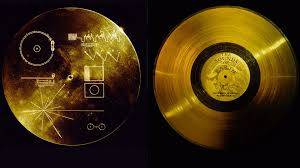
The voyage continues…
- Share full article
Advertisement
Supported by
Voyager 1, First Craft in Interstellar Space, May Have Gone Dark
The 46-year-old probe, which flew by Jupiter and Saturn in its youth and inspired earthlings with images of the planet as a “Pale Blue Dot,” hasn’t sent usable data from interstellar space in months.

By Orlando Mayorquin
When Voyager 1 launched in 1977, scientists hoped it could do what it was built to do and take up-close images of Jupiter and Saturn. It did that — and much more.
Voyager 1 discovered active volcanoes, moons and planetary rings, proving along the way that Earth and all of humanity could be squished into a single pixel in a photograph, a “ pale blue dot, ” as the astronomer Carl Sagan called it. It stretched a four-year mission into the present day, embarking on the deepest journey ever into space.
Now, it may have bid its final farewell to that faraway dot.
Voyager 1 , the farthest man-made object in space, hasn’t sent coherent data to Earth since November. NASA has been trying to diagnose what the Voyager mission’s project manager, Suzanne Dodd, called the “most serious issue” the robotic probe has faced since she took the job in 2010.
The spacecraft encountered a glitch in one of its computers that has eliminated its ability to send engineering and science data back to Earth.
The loss of Voyager 1 would cap decades of scientific breakthroughs and signal the beginning of the end for a mission that has given shape to humanity’s most distant ambition and inspired generations to look to the skies.
“Scientifically, it’s a big loss,” Ms. Dodd said. “I think — emotionally — it’s maybe even a bigger loss.”
Voyager 1 is one half of the Voyager mission. It has a twin spacecraft, Voyager 2.
Launched in 1977, they were primarily built for a four-year trip to Jupiter and Saturn , expanding on earlier flybys by the Pioneer 10 and 11 probes.
The Voyager mission capitalized on a rare alignment of the outer planets — once every 175 years — allowing the probes to visit all four.
Using the gravity of each planet, the Voyager spacecraft could swing onto the next, according to NASA .
The mission to Jupiter and Saturn was a success.
The 1980s flybys yielded several new discoveries, including new insights about the so-called great red spot on Jupiter, the rings around Saturn and the many moons of each planet.
Voyager 2 also explored Uranus and Neptune , becoming in 1989 the only spacecraft to explore all four outer planets.

Voyager 1, meanwhile, had set a course for deep space, using its camera to photograph the planets it was leaving behind along the way. Voyager 2 would later begin its own trek into deep space.
“Anybody who is interested in space is interested in the things Voyager discovered about the outer planets and their moons,” said Kate Howells, the public education specialist at the Planetary Society, an organization co-founded by Dr. Sagan to promote space exploration.
“But I think the pale blue dot was one of those things that was sort of more poetic and touching,” she added.
On Valentine’s Day 1990, Voyager 1, darting 3.7 billion miles away from the sun toward the outer reaches of the solar system, turned around and snapped a photo of Earth that Dr. Sagan and others understood to be a humbling self-portrait of humanity.
“It’s known the world over, and it does connect humanity to the stars,” Ms. Dodd said of the mission.
She added: “I’ve had many, many many people come up to me and say: ‘Wow, I love Voyager. It’s what got me excited about space. It’s what got me thinking about our place here on Earth and what that means.’”
Ms. Howells, 35, counts herself among those people.
About 10 years ago, to celebrate the beginning of her space career, Ms. Howells spent her first paycheck from the Planetary Society to get a Voyager tattoo.
Though spacecraft “all kind of look the same,” she said, more people recognize the tattoo than she anticipated.
“I think that speaks to how famous Voyager is,” she said.
The Voyagers made their mark on popular culture , inspiring a highly intelligent “Voyager 6” in “Star Trek: The Motion Picture” and references on “The X Files” and “The West Wing.”
Even as more advanced probes were launched from Earth, Voyager 1 continued to reliably enrich our understanding of space.
In 2012, it became the first man-made object to exit the heliosphere, the space around the solar system directly influenced by the sun. There is a technical debate among scientists around whether Voyager 1 has actually left the solar system, but, nonetheless, it became interstellar — traversing the space between stars.
That charted a new path for heliophysics, which looks at how the sun influences the space around it. In 2018, Voyager 2 followed its twin between the stars.
Before Voyager 1, scientific data on the sun’s gases and material came only from within the heliosphere’s confines, according to Dr. Jamie Rankin, Voyager’s deputy project scientist.
“And so now we can for the first time kind of connect the inside-out view from the outside-in,” Dr. Rankin said, “That’s a big part of it,” she added. “But the other half is simply that a lot of this material can’t be measured any other way than sending a spacecraft out there.”
Voyager 1 and 2 are the only such spacecraft. Before it went offline, Voyager 1 had been studying an anomalous disturbance in the magnetic field and plasma particles in interstellar space.
“Nothing else is getting launched to go out there,” Ms. Dodd said. “So that’s why we’re spending the time and being careful about trying to recover this spacecraft — because the science is so valuable.”
But recovery means getting under the hood of an aging spacecraft more than 15 billion miles away, equipped with the technology of yesteryear. It takes 45 hours to exchange information with the craft.
It has been repeated over the years that a smartphone has hundreds of thousands of times Voyager 1’s memory — and that the radio transmitter emits as many watts as a refrigerator lightbulb.
“There was one analogy given that is it’s like trying to figure out where your cursor is on your laptop screen when your laptop screen doesn’t work,” Ms. Dodd said.
Her team is still holding out hope, she said, especially as the tantalizing 50th launch anniversary in 2027 approaches. Voyager 1 has survived glitches before, though none as serious.
Voyager 2 is still operational, but aging. It has faced its own technical difficulties too.
NASA had already estimated that the nuclear-powered generators of both spacecrafts would likely die around 2025.
Even if the Voyager interstellar mission is near its end, the voyage still has far to go.
Voyager 1 and its twin, each 40,000 years away from the next closest star, will arguably remain on an indefinite mission.
“If Voyager should sometime in its distant future encounter beings from some other civilization in space, it bears a message,” Dr. Sagan said in a 1980 interview .
Each spacecraft carries a gold-plated phonograph record loaded with an array of sound recordings and images representing humanity’s richness, its diverse cultures and life on Earth.
“A gift across the cosmic ocean from one island of civilization to another,” Dr. Sagan said.
Orlando Mayorquin is a general assignment and breaking news reporter based in New York. More about Orlando Mayorquin
What’s Up in Space and Astronomy
Keep track of things going on in our solar system and all around the universe..
Never miss an eclipse, a meteor shower, a rocket launch or any other 2024 event that’s out of this world with our space and astronomy calendar .
Scientists may have discovered a major flaw in their understanding of dark energy, a mysterious cosmic force . That could be good news for the fate of the universe.
A new set of computer simulations, which take into account the effects of stars moving past our solar system, has effectively made it harder to predict Earth’s future and reconstruct its past.
Dante Lauretta, the planetary scientist who led the OSIRIS-REx mission to retrieve a handful of space dust , discusses his next final frontier.
A nova named T Coronae Borealis lit up the night about 80 years ago. Astronomers say it’s expected to put on another show in the coming months.
Is Pluto a planet? And what is a planet, anyway? Test your knowledge here .

- April 24, 2024 | Revolutionizing Renewable Energy: Innovative Salt Battery Efficiently Harvests Osmotic Power
- April 24, 2024 | 30 Times Clearer – Scientists Develop Improved Mid-Infrared Microscope
- April 24, 2024 | Shedding Pounds, Dodging Cancer: The Life-Saving Promise of Bariatric Surgery
- April 24, 2024 | Quantum Computing Meets Genomics: The Dawn of Hyper-Fast DNA Analysis
- April 24, 2024 | Scientists Turn to Venus in the Search for Alien Life
Major Accomplishments of NASA’s Voyager 1 and 2 Spacecraft
By Elizabeth Landau, Jet Propulsion Laboratory August 1, 2017
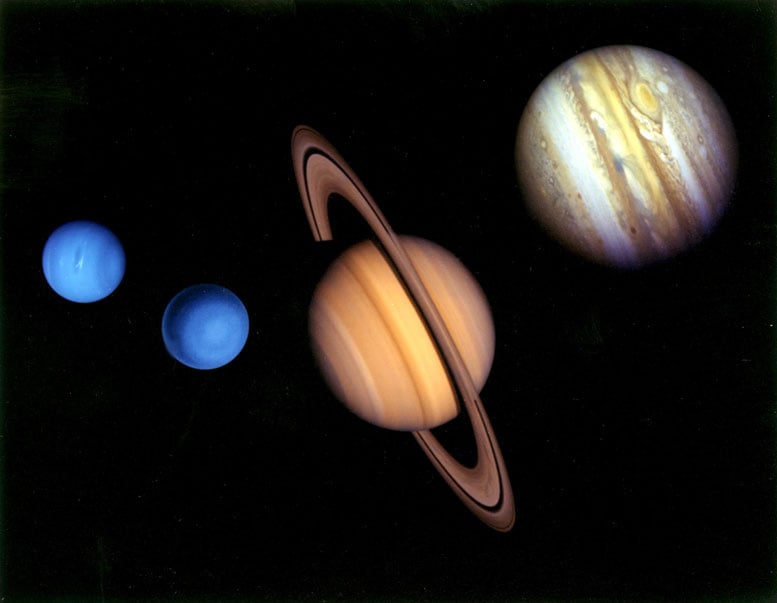
This montage of images of the planets visited by Voyager 2 was prepared from an assemblage of images taken by the 2 Voyager spacecraft. Credit: NASA/JPL
Below is a short list of the major accomplishments to date of NASA ’s groundbreaking Voyager 1 and 2 Spacecraft during their 40 years of exploration.
Planetary Firsts
Launched in 1977, the Voyagers delivered many surprises and discoveries from their encounters with the gas giants of the outer solar system: Jupiter , Saturn , Uranus and Neptune . Between 1977 and 1990, the mission attained these distinctions:
- First spacecraft to fly by all four planets of the outer solar system (Voyager 2)
- 3 new moons at Jupiter
- 4 new moons at Saturn
- 11 new moons at Uranus
- 6 new moons at Neptune
- First spacecraft to fly by four different target planets (Voyager 2)
- First spacecraft to visit Uranus and Neptune (Voyager 2)
- First spacecraft to image the rings of Jupiter, Uranus and Neptune (Voyager 2)
- First spacecraft to discover active volcanoes beyond Earth (on Jupiter’s moon Io — Voyager 1)
- First spacecraft to detect lightning on a planet other than Earth (at Jupiter — Voyager 1)
- First spacecraft to find suggestions of an ocean beyond Earth (at Jupiter’s moon Europa — both spacecraft)
- First spacecraft to detect a nitrogen-rich atmosphere found beyond our home planet (at Saturn’s moon Titan — Voyager 1)
Heliophysics Firsts
After Voyager 1 departed from Saturn in November 1980, it began a journey to where no human-made object had ever gone before: the space between the stars. On August 25, 2012, it crossed over into interstellar space, leaving behind the heliosphere — the enormous magnetic bubble encompassing our Sun, planets, and solar wind. Voyager 2 set course for interstellar space after departing from Neptune in August 1989, and is expected to enter interstellar space in the next few years. Together the Voyagers have taught us a great deal about the extent of our sun’s influence and the very nature of the space that lies beyond our planets.
- First spacecraft to leave the heliosphere and enter interstellar space (Voyager 1)
- First spacecraft to measure full intensity of cosmic rays — atoms accelerated to nearly the speed of light — in interstellar space (Voyager 1)
- First spacecraft to measure magnetic field in interstellar space (Voyager 1)
- First spacecraft to measure density of interstellar medium — material ejected by ancient supernovae (Voyager 1)
- First spacecraft to measure solar wind termination shock — the boundary where solar wind charged particles slow below the speed of sound as they begin to press into the interstellar medium (Voyager 2)
Engineering and Computing Firsts and Records
The Voyagers, which launched with nearly identical configurations and instruments, were designed to withstand the harsh radiation environment of Jupiter — the greatest physical challenge they would ever encounter. Preparations for the peril at Jupiter ensured that the Voyagers would be well-equipped for the rest of their journeys, too. Engineering and computing advances that the Voyagers debuted set the stage for future missions.
- First spacecraft extensively protected against radiation, which also set the standard for radiation design margin still in use for space missions today
- First spacecraft protected against external electrostatic discharges
- First spacecraft with programmable computer-controlled attitude and articulation (which means the pointing of the spacecraft)
- First spacecraft with autonomous fault protection, able to detect its own problems and take corrective action
- First use of Reed-Solomon code for spacecraft data — an algorithm to reduce errors in data transmission and storage, which is widely used today
- First time engineers linked ground communications antennas together in an array to be able to receive more data (for Voyager 2’s Uranus encounter)
Beyond that, the Voyager spacecraft continue setting endurance and distance records:
- Longest continuously operating spacecraft (Voyager 2, which passed Pioneer 6’s record on August 13, 2012)
- Most distant spacecraft from the Sun (Voyager 1, which passed Pioneer 10’s distance on February 17, 1998 and is currently about 13 billion miles, or 21 billion kilometers, away)
The Voyager spacecraft were built by NASA’s Jet Propulsion Laboratory, Pasadena, California, which continues to operate both. JPL is a division of Caltech in Pasadena. The Voyager missions are a part of the NASA Heliophysics System Observatory, sponsored by the Heliophysics Division of the Science Mission Directorate in Washington.
More on SciTechDaily
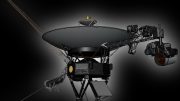
NASA’s Longest-Lived Mission: Voyager Probes Log 45 Years in Space

It’s Official – Voyager 1 Has Entered Interstellar Space
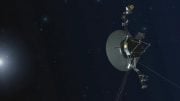
Voyager 2 Illuminates Boundary of Interstellar Space 11 Billion Miles From Earth
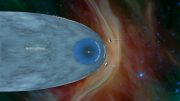
Voyager 2 Probe Enters Interstellar Space, Over 18 Billion Kilometers from Earth
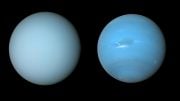
New Discovery Reveals Why Uranus and Neptune Are Different Colors
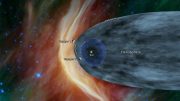
Hear the Eerie Sounds of Interstellar Space Captured by NASA’s Voyager
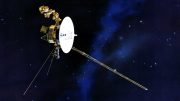
Voyager Spacecraft Poised to Make New Discoveries
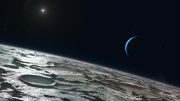
China’s Nuclear-Powered Mission to Neptune
1 comment on "major accomplishments of nasa’s voyager 1 and 2 spacecraft".
Great Craft ! Great contribution.. The twin Voyager 1 and 2 spacecraft are exploring where nothing from Earth has flown before. Continuing on their more-than-40-year journey Regards Dav
Leave a comment Cancel reply
Email address is optional. If provided, your email will not be published or shared.
Save my name, email, and website in this browser for the next time I comment.
- Skip to main content
- Keyboard shortcuts for audio player
Well, hello, Voyager 1! The venerable spacecraft is once again making sense

Nell Greenfieldboyce

Members of the Voyager team celebrate at NASA's Jet Propulsion Laboratory after receiving data about the health and status of Voyager 1 for the first time in months. NASA/JPL-Caltech hide caption
Members of the Voyager team celebrate at NASA's Jet Propulsion Laboratory after receiving data about the health and status of Voyager 1 for the first time in months.
NASA says it is once again able to get meaningful information back from the Voyager 1 probe, after months of troubleshooting a glitch that had this venerable spacecraft sending home messages that made no sense.
The Voyager 1 and Voyager 2 probes launched in 1977 on a mission to study Jupiter and Saturn but continued onward through the outer reaches of the solar system. In 2012, Voyager 1 became the first spacecraft to enter interstellar space, the previously unexplored region between the stars. (Its twin, traveling in a different direction, followed suit six years later.)
Voyager 1 had been faithfully sending back readings about this mysterious new environment for years — until November, when its messages suddenly became incoherent .

NASA's Voyager 1 spacecraft is talking nonsense. Its friends on Earth are worried
It was a serious problem that had longtime Voyager scientists worried that this historic space mission wouldn't be able to recover. They'd hoped to be able to get precious readings from the spacecraft for at least a few more years, until its power ran out and its very last science instrument quit working.
For the last five months, a small team at NASA's Jet Propulsion Laboratory in California has been working to fix it. The team finally pinpointed the problem to a memory chip and figured out how to restore some essential software code.
"When the mission flight team heard back from the spacecraft on April 20, they saw that the modification worked: For the first time in five months, they have been able to check the health and status of the spacecraft," NASA stated in an update.
The usable data being returned so far concerns the workings of the spacecraft's engineering systems. In the coming weeks, the team will do more of this software repair work so that Voyager 1 will also be able to send science data, letting researchers once again see what the probe encounters as it journeys through interstellar space.

After a 12.3 billion-mile 'shout,' NASA regains full contact with Voyager 2
- interstellar mission
NASA's Voyager 1 spacecraft finally phones home after 5 months of no contact
On Saturday, April 5, Voyager 1 finally "phoned home" and updated its NASA operating team about its health.

NASA's interstellar explorer Voyager 1 is finally communicating with ground control in an understandable way again. On Saturday (April 20), Voyager 1 updated ground control about its health status for the first time in 5 months. While the Voyager 1 spacecraft still isn't sending valid science data back to Earth, it is now returning usable information about the health and operating status of its onboard engineering systems.
Thirty-five years after its launch in 1977, Voyager 1 became the first human-made object to leave the solar system and enter interstellar space . It was followed out of our cosmic quarters by its space-faring sibling, Voyager 2 , six years later in 2018. Voyager 2, thankfully, is still operational and communicating well with Earth.
The two spacecraft remain the only human-made objects exploring space beyond the influence of the sun. However, on Nov. 14, 2023, after 11 years of exploring interstellar space and while sitting a staggering 15 billion miles (24 billion kilometers) from Earth, Voyager 1's binary code — computer language composed of 0s and 1s that it uses to communicate with its flight team at NASA — stopped making sense.
Related: We finally know why NASA's Voyager 1 spacecraft stopped communicating — scientists are working on a fix
In March, NASA's Voyager 1 operating team sent a digital "poke" to the spacecraft, prompting its flight data subsystem (FDS) to send a full memory readout back home.
This memory dump revealed to scientists and engineers that the "glitch" is the result of a corrupted code contained on a single chip representing around 3% of the FDS memory. The loss of this code rendered Voyager 1's science and engineering data unusable.

The NASA team can't physically repair or replace this chip, of course, but what they can do is remotely place the affected code elsewhere in the FDS memory. Though no single section of the memory is large enough to hold this code entirely, the team can slice it into sections and store these chunks separately. To do this, they will also have to adjust the relevant storage sections to ensure the addition of this corrupted code won't cause those areas to stop operating individually, or working together as a whole. In addition to this, NASA staff will also have to ensure any references to the corrupted code's location are updated.
Get the Space.com Newsletter
Breaking space news, the latest updates on rocket launches, skywatching events and more!
— Voyager 2: An iconic spacecraft that's still exploring 45 years on
— NASA's interstellar Voyager probes get software updates beamed from 12 billion miles away
— NASA Voyager 2 spacecraft extends its interstellar science mission for 3 more years
On April 18, 2024, the team began sending the code to its new location in the FDS memory. This was a painstaking process, as a radio signal takes 22.5 hours to traverse the distance between Earth and Voyager 1, and it then takes another 22.5 hours to get a signal back from the craft.
By Saturday (April 20), however, the team confirmed their modification had worked. For the first time in five months, the scientists were able to communicate with Voyager 1 and check its health. Over the next few weeks, the team will work on adjusting the rest of the FDS software and aim to recover the regions of the system that are responsible for packaging and returning vital science data from beyond the limits of the solar system.
Join our Space Forums to keep talking space on the latest missions, night sky and more! And if you have a news tip, correction or comment, let us know at: [email protected].

Robert Lea is a science journalist in the U.K. whose articles have been published in Physics World, New Scientist, Astronomy Magazine, All About Space, Newsweek and ZME Science. He also writes about science communication for Elsevier and the European Journal of Physics. Rob holds a bachelor of science degree in physics and astronomy from the U.K.’s Open University. Follow him on Twitter @sciencef1rst.
Boeing Starliner 1st astronaut flight: Live updates
'Rocket cam' takes you aboard final launch of ULA's Delta IV Heavy (video)
Watch 2 gorgeous supernova remnants evolve over 20 years (timelapse video)
- Robb62 'V'ger must contact the creator. Reply
- Holy HannaH! Couldn't help but think that "repair" sounded extremely similar to the mechanics of DNA and the evolution of life. Reply
- Torbjorn Larsson *Applause* indeed, thanks to the Voyager teams for the hard work! Reply
- SpaceSpinner I notice that the article says that it has been in space for 35 years. Either I have gone back in time 10 years, or their AI is off by 10 years. V-*ger has been captured! Reply
Admin said: On Saturday, April 5, Voyager 1 finally "phoned home" and updated its NASA operating team about its health. The interstellar explorer is back in touch after five months of sending back nonsense data. NASA's Voyager 1 spacecraft finally phones home after 5 months of no contact : Read more
evw said: I'm incredibly grateful for the persistence and dedication of the Voyagers' teams and for the amazing accomplishments that have kept these two spacecrafts operational so many years beyond their expected lifetimes. V-1 was launched when I was 25 years young; I was nearly delirious with joy. Exploring the physical universe captivated my attention while I was in elementary school and has kept me mesmerized since. I'm very emotional writing this note, thinking about what amounts to a miracle of technology and longevity in my eyes. BRAVO!!! THANK YOU EVERYONE PAST & PRESENT!!!
- EBairead I presume it's Fortran. Well done all. Reply
SpaceSpinner said: I notice that the article says that it has been in space for 35 years. Either I have gone back in time 10 years, or their AI is off by 10 years. V-*ger has been captured!
EBairead said: I presume it's Fortran. Well done all.
- View All 11 Comments
Most Popular
- 2 Boeing Starliner 1st astronaut flight: Live updates
- 3 US Space Force picks Rocket Lab for 2025 Victus Haze space domain awareness mission
- 4 Exploding stars send out powerful bursts of energy − I'm leading a citizen scientist project to classify and learn about these bright flashes
- 5 Wow! Private space-junk probe snaps historic photo of discarded rocket in orbit
Contact restored with NASA’s Voyager 1 space probe

Contact restored.
That was the message relieved NASA officials shared after the agency regained full contact with the Voyager 1 space probe, the most distant human-made object in the universe, scientists have announced.
For the first time since November, the spacecraft is returning usable data about the health and status of its onboard engineering systems, NASA said in a news release Monday.
The 46-year-old pioneering probe, now 15.1 billion miles from Earth, has continually defied expectations for its life span as it ventures farther into the uncharted territory of the cosmos .
More: Voyager 1 is 15 billion miles from home and broken. Here's how NASA is trying to fix it.
Computer experts to the rescue
It wasn't as easy as hitting Control-Alt-Delete, but top experts at NASA and CalTech were able to fix the balky, ancient computer on board the probe that was causing the communication breakdown – at least for now.
A computer problem aboard Voyager 1 on Nov. 14, 2023, corrupted the stream of science and engineering data the craft sent to Earth, making it unreadable .
Although the radio signal from the spacecraft had never ceased its connection to ground control operators on Earth, that signal had not carried any usable data since November, NASA said. After some serious sleuthing to fix the onboard computer, that changed on April 20, when NASA finally received usable data.
In interstellar space
The probe and its twin, Voyager 2, are the only spacecraft to ever fly in interstellar space (the space between the stars).
Voyager 2 continues to operate normally, NASA reports. Launched more than 46 years ago , the twin spacecraft are standouts on two fronts: they've operated the longest and traveled the farthest of any spacecraft ever.
Before the start of their interstellar exploration, both probes flew by Saturn and Jupiter, and Voyager 2 flew by Uranus and Neptune.
More: NASA gave Voyager 1 a 'poke' amid communication woes. Here's why the response was encouraging.
They were designed to last five years but have become the longest-operating spacecraft in history. Both carry gold-plated copper discs containing sounds and images from Earth, content that was chosen by a team headed by celebrity astronomer Carl Sagan .
For perspective, it was the summer of 1977 when the Voyager probes left Earth. "Star Wars" was No. 1 at the box office, Jimmy Carter was in the first year of his presidency, and Elvis Presley had just died.
Contributing: Eric Lagatta and George Petras

Interstellar Messengers
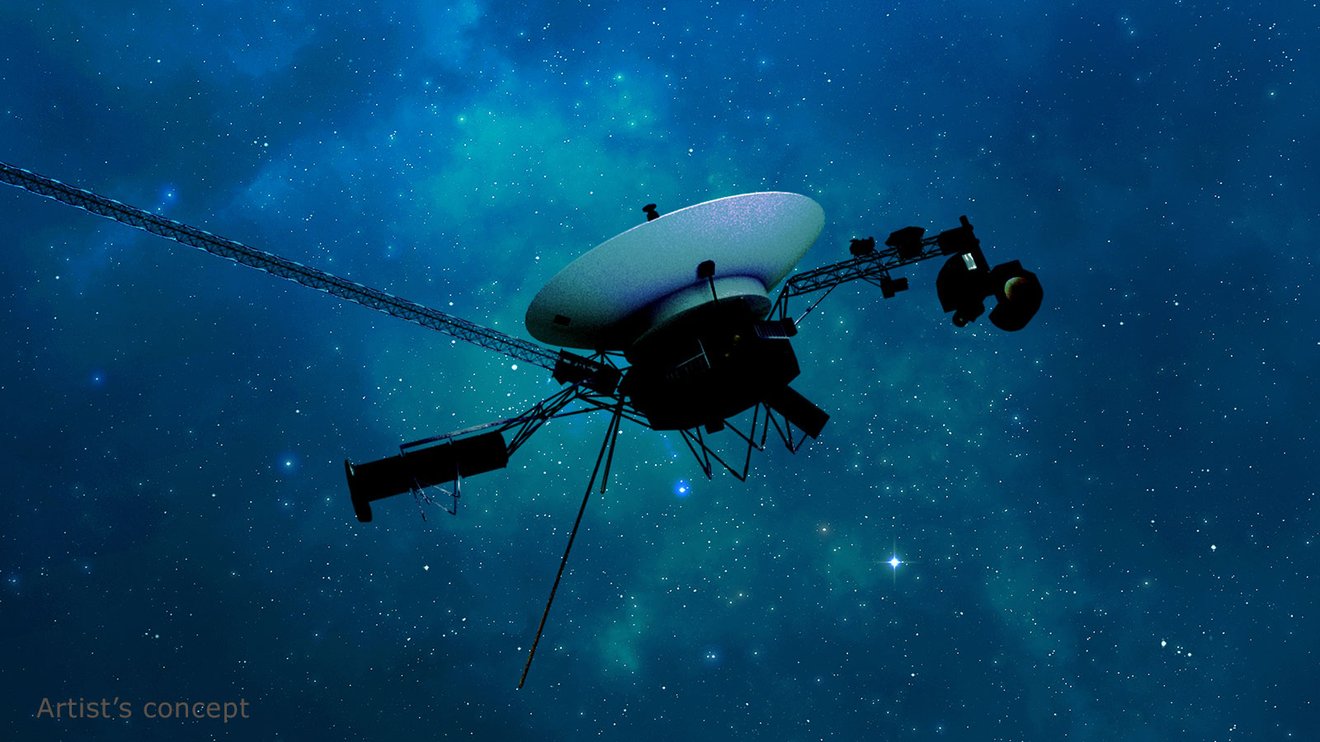
Voyager 1 and its twin Voyager 2 are the only spacecraft ever to operate outside the heliosphere, the protective bubble of particles and magnetic fields generated by the Sun. Voyager 1 reached the interstellar boundary in 2012, while Voyager 2 (traveling slower and in a different direction than its twin) reached it in 2018.
Mission Type
Science Targets
Voyager 1 & 2
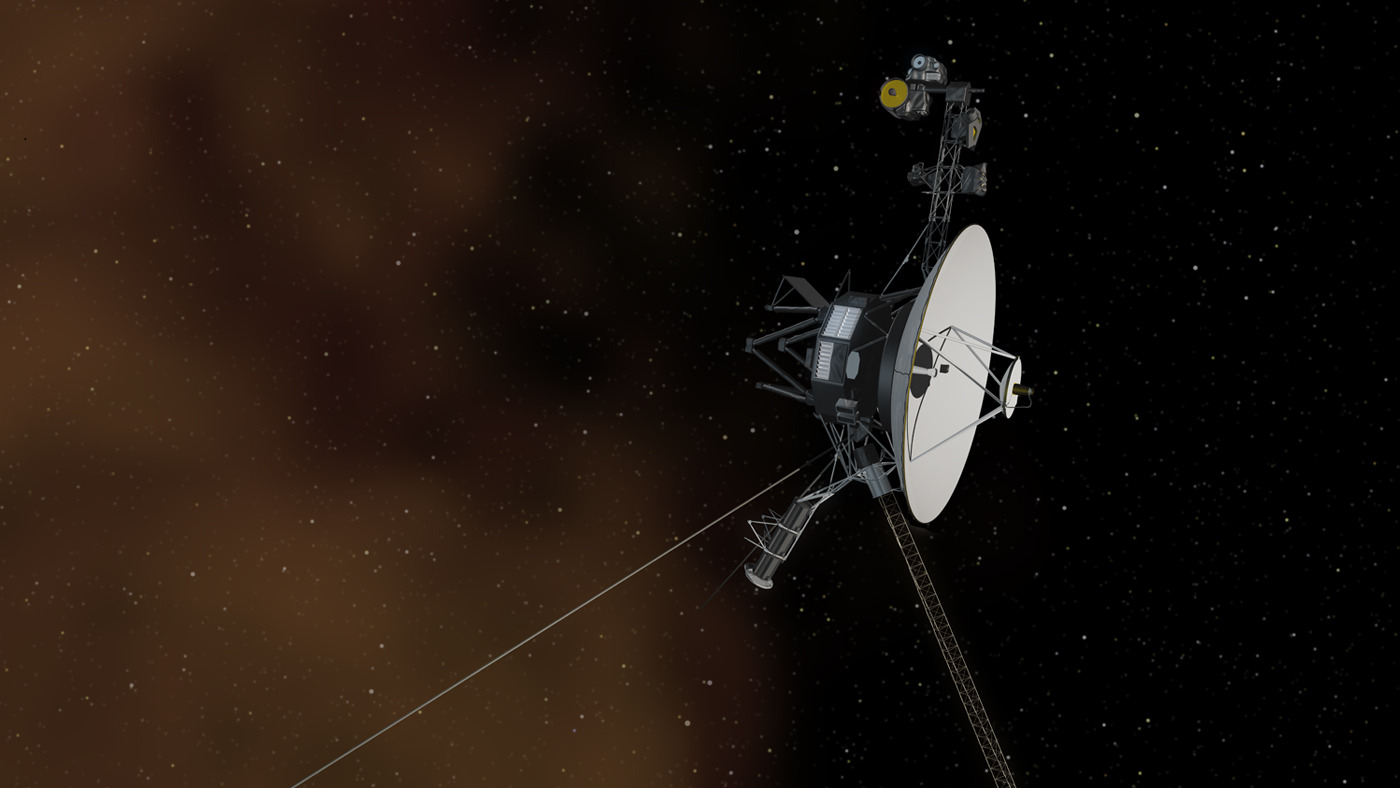
Mission Updates
Voyager 1 resumes sending engineering updates to Earth.
Latest News
NASA’s Voyager Team Focuses on Software Patch, Thrusters
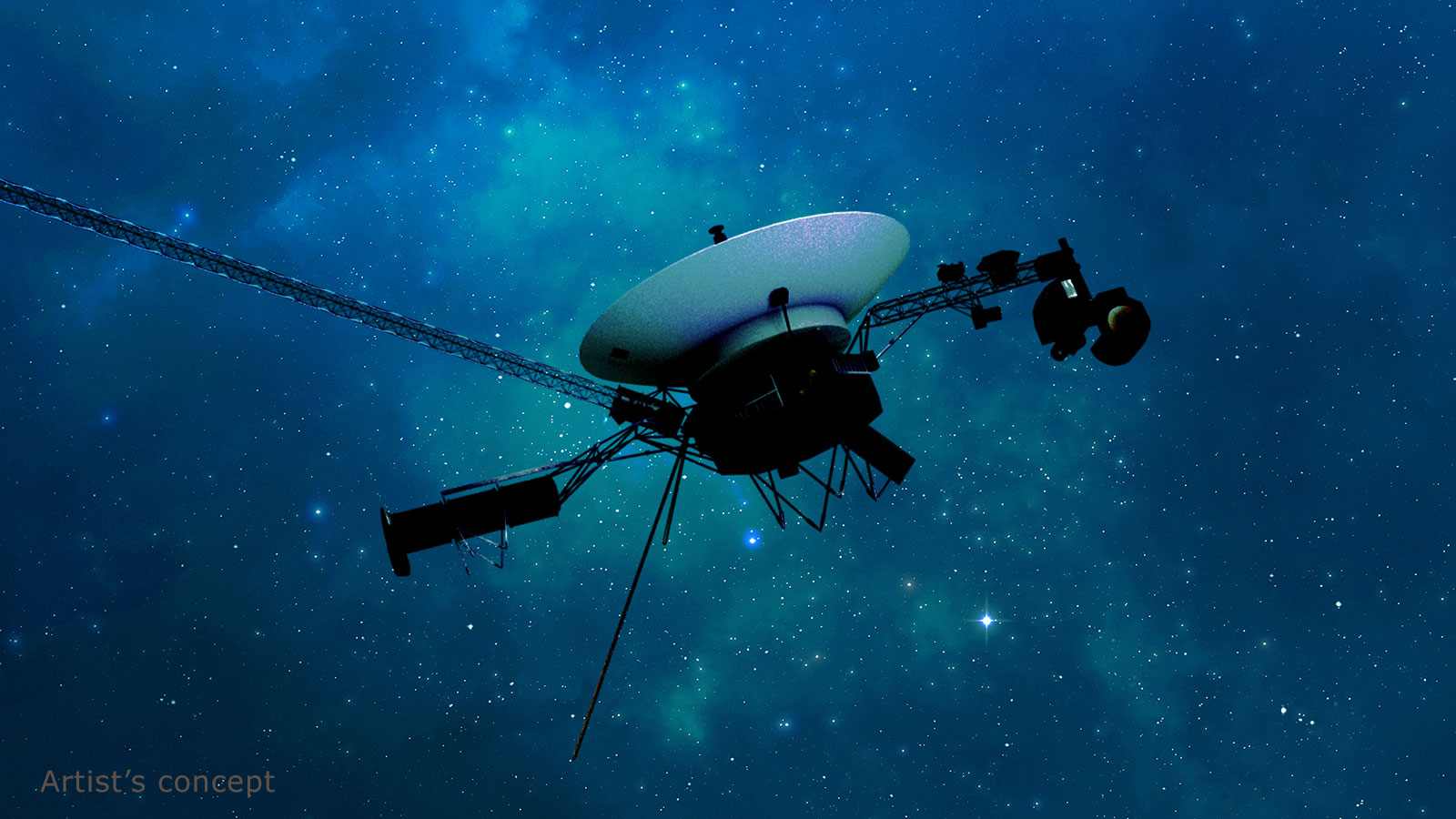
NASA’s Voyager Will Do More Science With New Power Strategy
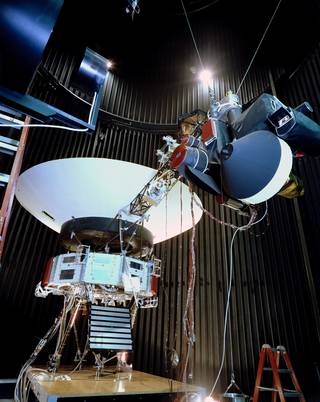
Edward Stone Retires After 50 Years as NASA Voyager’s Project Scientist
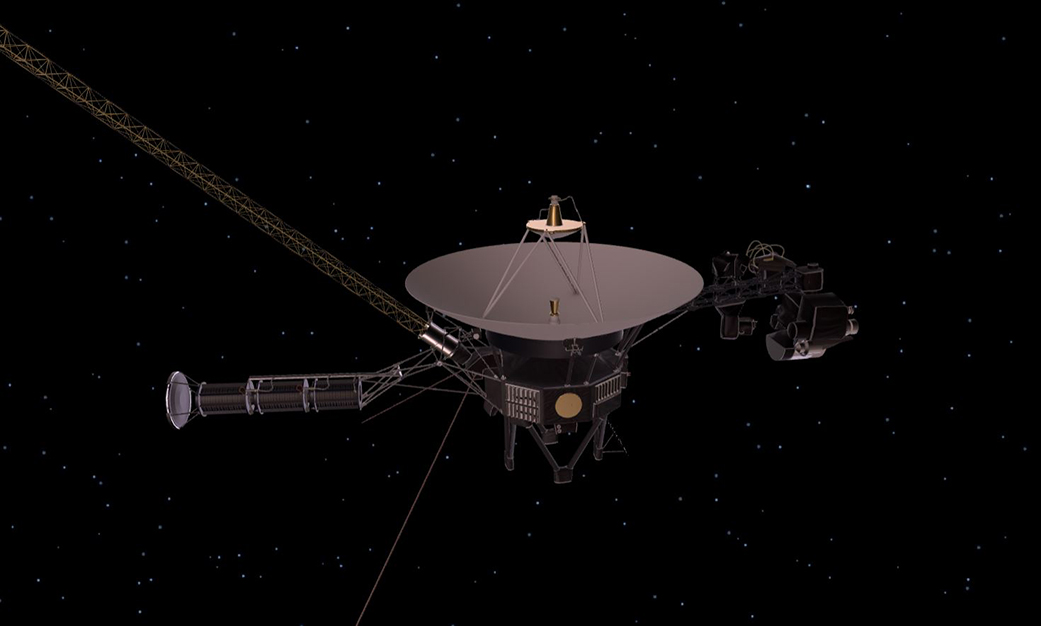
Engineers Solve Data Glitch on NASA’s Voyager 1
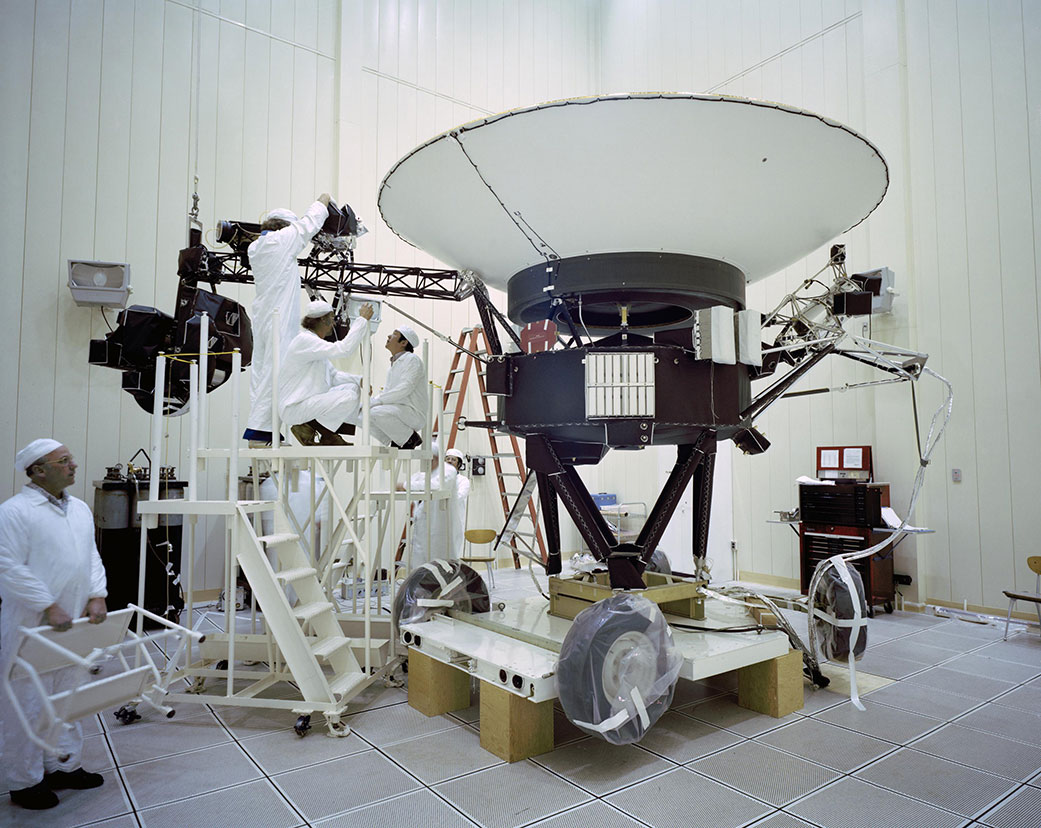
Voyager, NASA’s Longest-Lived Mission, Logs 45 Years in Space
The Interstellar Mission
After completing the first in-depth reconnaissance of the outer planets, the twin Voyagers are on a new mission to chart the edge of interstellar space.
The Golden Record
The contents of the golden record were selected for NASA by a committee led by Carl Sagan of Cornell University.
The Spacecraft
The twin Voyagers are escaping our solar system in different directions at more than 3 astronomical units (AU) a year.
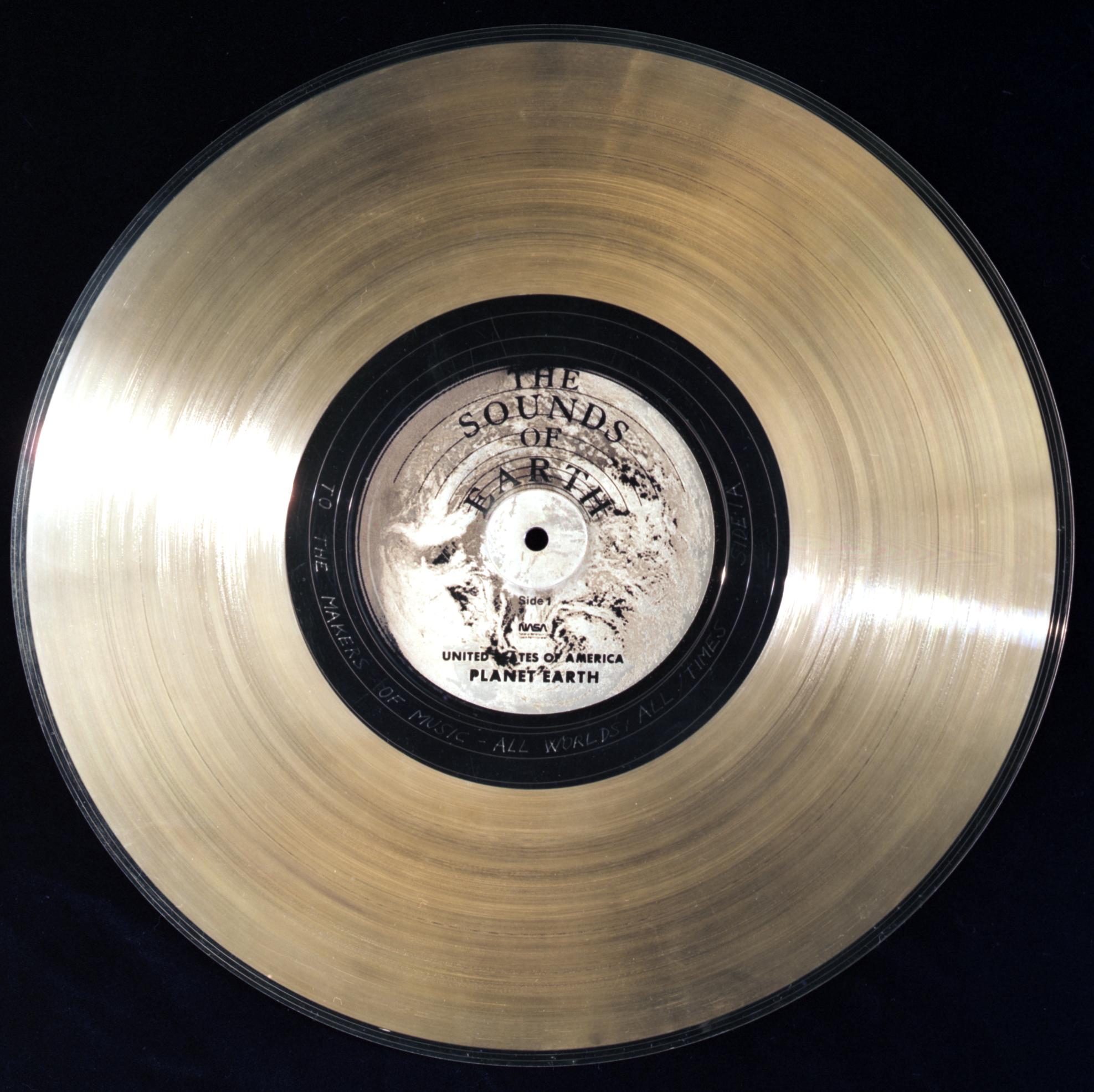
The Pale Blue Dot
The behind-the-scenes story of the making of Voyager 1's iconic image of Earth as "a mote of dust suspended in a sunbeam."
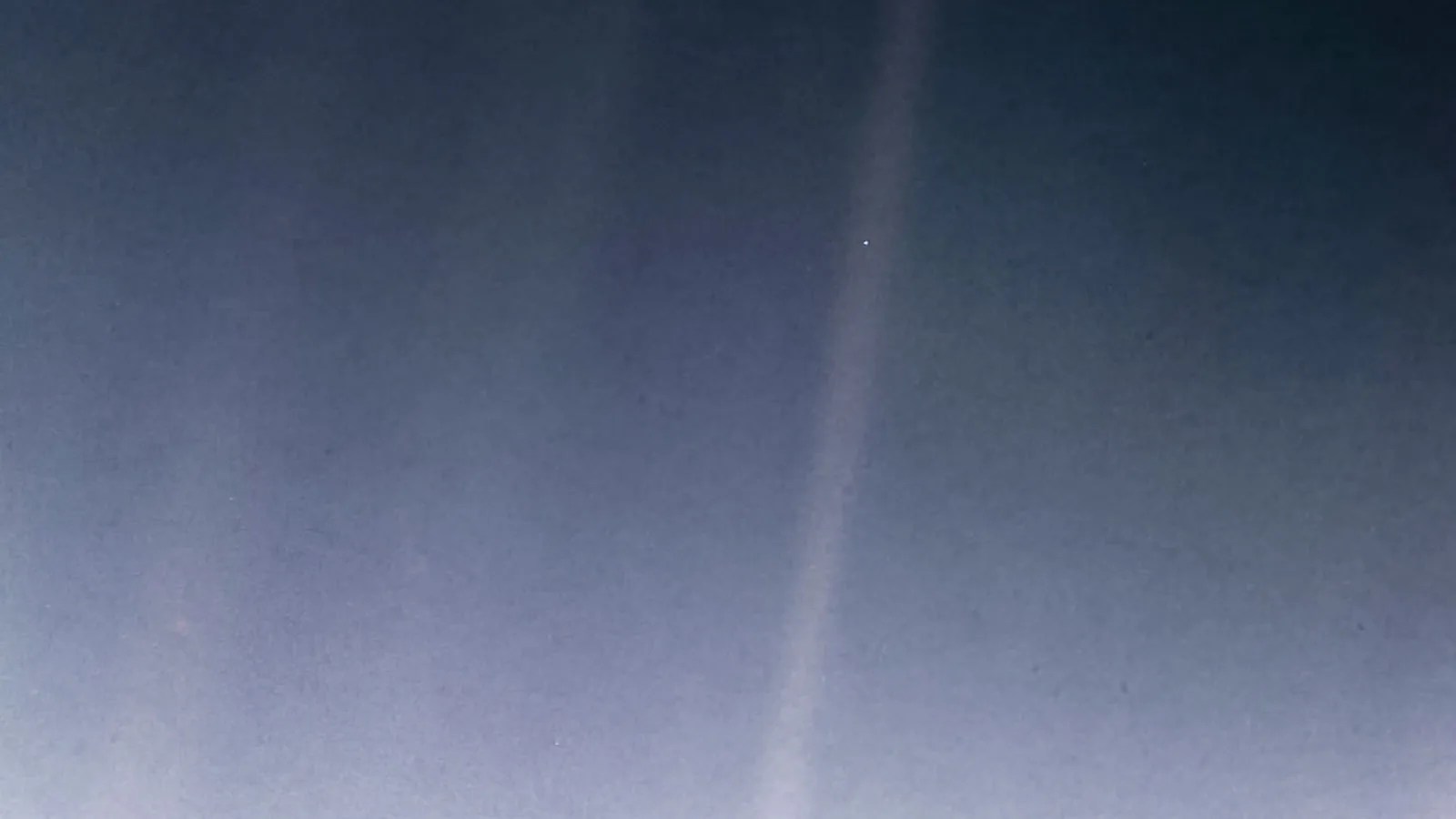
Discover More Topics From NASA

Our Solar System

Heliosphere
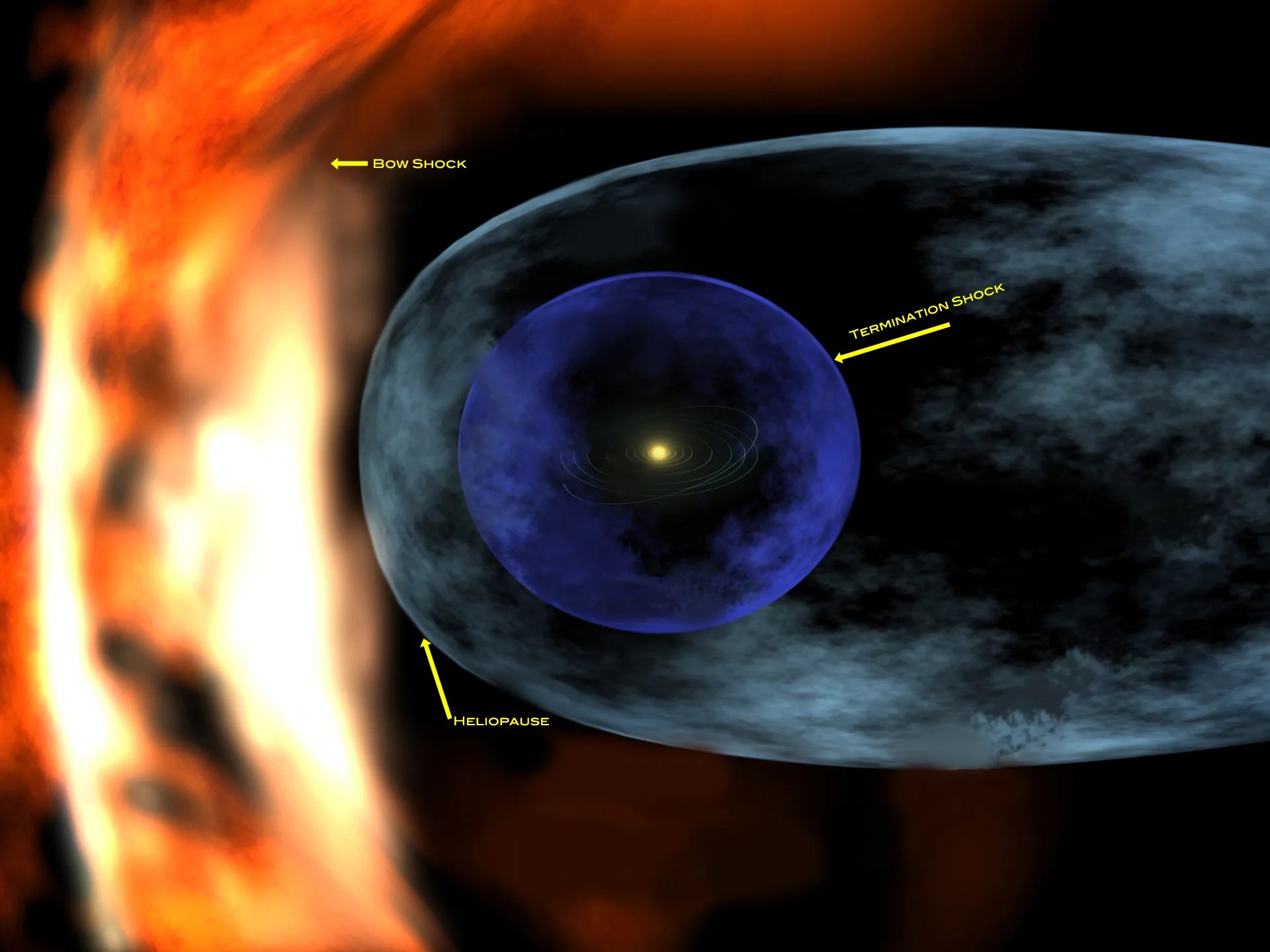
14.6 billion miles away, NASA gets Voyager 1 talking again — and discovers a new mystery
That’s some repair job.
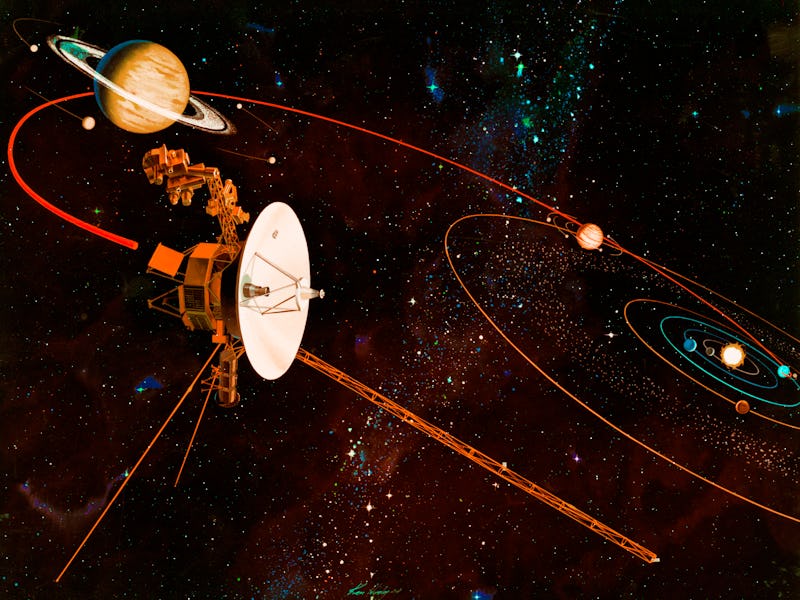
NASA’s Voyager 1 is on a fraught and unknowable journey into deep space. Some 14.6 billion miles from Earth, it and its sister craft, Voyager 2, are the furthest human-made objects from our planet, having made it beyond the edges of the Solar System and out into the interstellar medium. At such distances, anything can go wrong. Add to that the fact that these are old craft: The Voyagers launched in the 1970s. So when Voyager 1 started to send home weird, garbled nonsense instead of telemetry data in May of this year , NASA engineers might have been forgiven for calling it a day and pouring one out for perhaps the most successful space mission of all time.
But that’s not how NASA works . Instead, they started working on a remote diagnosis and fix for the record-breaking spacecraft. Now, some four months later, they are triumphant. Voyager 1 is back online and communicating perfectly with ground control as if it never happened. In fact, the fix turned out to be relatively simple — or as simple as anything can be with a 22-hour communications lag in each direction and billions of miles of space in between.
What happened to Voyager 1?
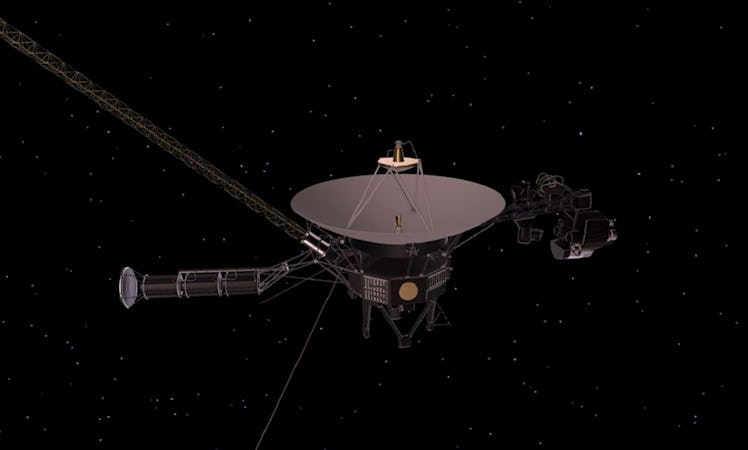
The high-gain antenna, shown on the left in this illustration, is how Voyager 1 sends and receives radio communications with NASA engineers here on Earth.
Cruising in interstellar space, the 45-year-old spacecraft appeared to be operating shockingly well and was transmitting reams of data back to Earth. But in mid-May, Voyager 1’s onboard system responsible for keeping its high-gain antenna pointed at Earth, known as the attitude articulation and control system, or AACS, started beaming home confusing jumbles of data instead of the usual reports about the spacecraft’s health and status. From our viewpoint, it appeared as if the spacecraft had developed something like an electronic version of aphasia — a condition that causes the loss of fluent speech.
“The data may appear to be randomly generated, or does not reflect any possible state the AACS could be in,” explained NASA in a statement from the time.
Even more bafflingly for engineers, Voyager 1 appeared to be in perfect condition despite the spacecraft’s bizarre status reports. The radio signal from the ship remained strong and steady, which meant the antenna was still pointed at Earth — and not in whatever configuration the AACS was claiming it was in to NASA in the reports. Similarly, Voyager 1’s science systems kept gathering and transmitting data as usual, without any of the same strangeness affecting the AACS. And, whatever was wrong with the AACS didn’t trip a fault protection system designed to put the spacecraft in safe mode when there’s a glitch.
Thankfully, NASA engineers diagnosed the problem. And with the diagnosis, they could employ a cure.
The fix — It turned out that the AACS had started sending its telemetry data via an onboard computer that had stopped working years ago. The dead computer corrupted all the outgoing data. All NASA engineers had to do was send the command to the AACS to use the correct computer to send its data home.
But there’s still a problem — The next challenge will be to figure out exactly what caused the AACS to switch computers in the first place. NASA says the system probably received a faulty command from another onboard computer. While they say it is not a major concern for Voyager 1’s well-being right now, the true culprit will need to be found and fixed to prevent future weirdness.
Voyager 1 lives on
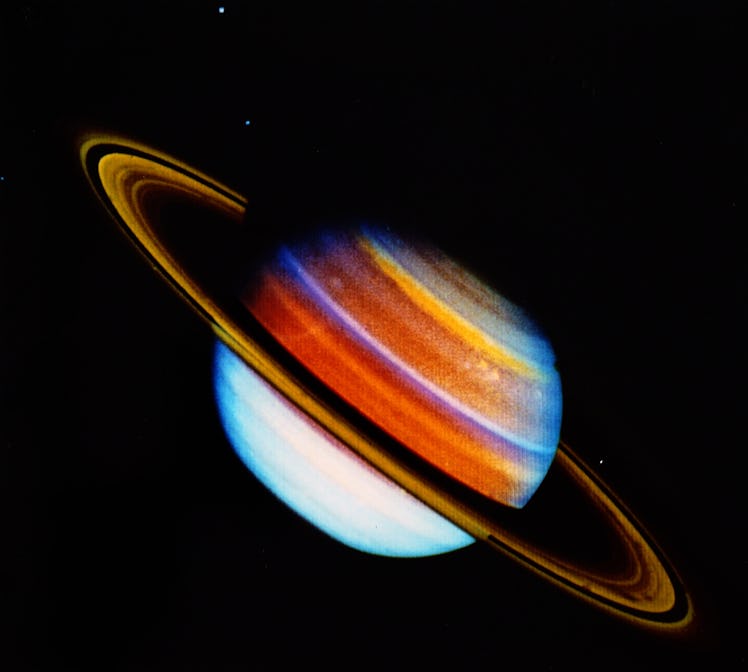
Voyager 1 has yielded revelations about our Solar System no one could have predicted.
Currently, Voyager 1 is more than 23.4 billion kilometers or 14.6 billion miles (and gaining, most of the time ) from Earth. You can watch the distance grow and see both Voyager spacecraft’s current positions in space on NASA’s website .
For the last decade, Voyager 1 has been cruising in interstellar space, beyond the reach of our Sun’s magnetic field. The field had offered the craft a little protection from cosmic rays and other interstellar radiation, much as Earth’s magnetic field offers some protection from high-energy particles and radiation from the Sun. Cosmic rays are known to interfere with electronics here on Earth — when one of those high-speed energetic particles strikes a computer chip, it can cause small memory errors, which add up over time — and it’s reasonable to expect that to be an issue for Voyager 1’s onboard computers, too.
“A mystery like this is sort of par for the course at this stage of the Voyager mission,” said Voyager 1 and 2 project manager Suzanne Dodd in a statement dated to May.
“The spacecraft are both almost 45 years old, which is far beyond what the mission planners anticipated. We’re also in interstellar space — a high-radiation environment that no spacecraft have flown in before.”
We’ll need to wait and see what new perils encounter Voyager next on its travels — and what new discoveries await.
Subscribe for free to Inverse’s award-winning daily newsletter.
This article was originally published on Aug. 31, 2022
- Space Science

IMAGES
VIDEO
COMMENTS
Voyager 1 is the most distant human-made object active, having crossed into interstellar space in 2012. It discovered a thin ring around Jupiter, two new moons, and five new moons and a new ring at Saturn.
Voyager 1 is a space probe launched by NASA on September 5, 1977, as part of the Voyager program to study the outer Solar System and the interstellar space beyond the Sun's heliosphere. ... The discovery of ongoing volcanic activity on the moon Io was probably the greatest surprise.
The probe and its twin, Voyager 2, are the only spacecraft to ever fly in interstellar space (the space between stars). Voyager 1 stopped sending readable science and engineering data back to Earth on Nov. 14, 2023, even though mission controllers could tell the spacecraft was still receiving their commands and otherwise operating normally.
Voyager 1 and 2 have made numerous scientific discoveries, including taking detailed recordings of Saturn and revealing that Jupiter also has rings, as well as active volcanism on one of its moons ...
The Voyager 1 probe is the most distant human-made object in existence. After a major effort to restore communication with it, NASA announced success this week. IE 11 is not supported.
Since Voyager 1 is so far away, testing solutions to its technical issues requires time—it takes 22.5 hours for commands to reach the probe and another 22.5 hours for Voyager 1's response to ...
Four and a half decades after launch and over 14 billion miles from Earth, Voyager 1 still makes new discoveries. The spacecraft has picked up the signature of interstellar space itself, a faint ...
The first such fix was transmitted to Voyager 1 on April 18. With a total distance of 30 billion miles to cross from Earth to the spacecraft and back, the team had to wait nearly two full days for ...
Today, 45 years after its launch and 14.6 billion miles from Earth, four of Voyager 1's 11 instruments continue to return useful data, having now spent 10 years in interstellar space. Signals from the spacecraft take nearly 22 hours to reach Earth, and 22 hours for Earth-based signals to reach the spacecraft.
But the Voyagers were more sophisticated than the Pioneers and made many startling discoveries. Voyager 1 took a shorter route than Voyager 2 and arrived at Jupiter first, in 1979, finding that the planet's colorful moon Io sported erupting volcanoes. In 1980, Voyager 1 sped past Saturn, spying intricate details in the planet's rings and ...
The Pale Blue Dot is a photograph of Earth taken Feb. 14, 1990, by NASA's Voyager 1 at a distance of 3.7 billion miles (6 billion kilometers) from the Sun. NASA/JPL-Caltech. Voyager 1, meanwhile ...
On February 17, 1998, Voyager 1 overtook the space probe Pioneer 10 (launched 1972) to become the most distant human-made object in space. By 2004 both Voyagers were well beyond the orbit of Pluto.In 2012 the Voyagers became the longest-operating spacecraft, having functioned for 35 years and still periodically transmitting data. On August 25, 2012, Voyager 1 became the first space probe to ...
Below is a short list of the major accomplishments to date of NASA 's groundbreaking Voyager 1 and 2 Spacecraft during their 40 years of exploration.. Planetary Firsts. Launched in 1977, the Voyagers delivered many surprises and discoveries from their encounters with the gas giants of the outer solar system: Jupiter, Saturn, Uranus and Neptune.Between 1977 and 1990, the mission attained ...
The Voyager 1 and Voyager 2 probes launched in 1977 on a mission to study Jupiter and Saturn but continued onward through the outer reaches of the solar system. In 2012, Voyager 1 became the first ...
The discovery wasn't made official until 2013, however, when scientists had time to review the data sent back from Voyager 1. Voyager 1 was the second of the twin spacecraft to launch, but it was ...
Voyager 2 was launched first, on August 20, 1977; Voyager 1 followed some two weeks later, on September 5. The twin-spacecraft mission took advantage of a rare orbital positioning of Jupiter, Saturn, Uranus, and Neptune that permitted a multiplanet tour with relatively low fuel requirements and flight time. The alignment allowed each spacecraft, following a particular trajectory, to use its ...
Voyager 2's priceless data is captured and returned to Earth through its five science instruments, while Voyager 1 still has four operational instruments after one failed earlier in the mission.
Voyager 1 is sending data back to Earth for the first time in 5 months ... Explore the universe with news on fascinating discoveries, scientific advancements and more. CNN —
On Saturday (April 20), Voyager 1 updated ground control about its health status for the first time in 5 months. ... Discovery' season 5 episode 5 'Mirrors' is a quality installment, but weighed ...
That was the message relieved NASA officials shared after the agency regained full contact with the Voyager 1 space probe, the most distant human-made object in the universe, scientists have ...
Voyager 1 and its twin Voyager 2 are the only spacecraft ever to operate outside the heliosphere, the protective bubble of particles and magnetic fields generated by the Sun. Voyager 1 reached the interstellar boundary in 2012, while Voyager 2 (traveling slower and in a different direction than its twin) reached it in 2018.
Voyager 1 has yielded revelations about our Solar System no one could have predicted. Currently, Voyager 1 is more than 23.4 billion kilometers or 14.6 billion miles (and gaining, most of the time ...